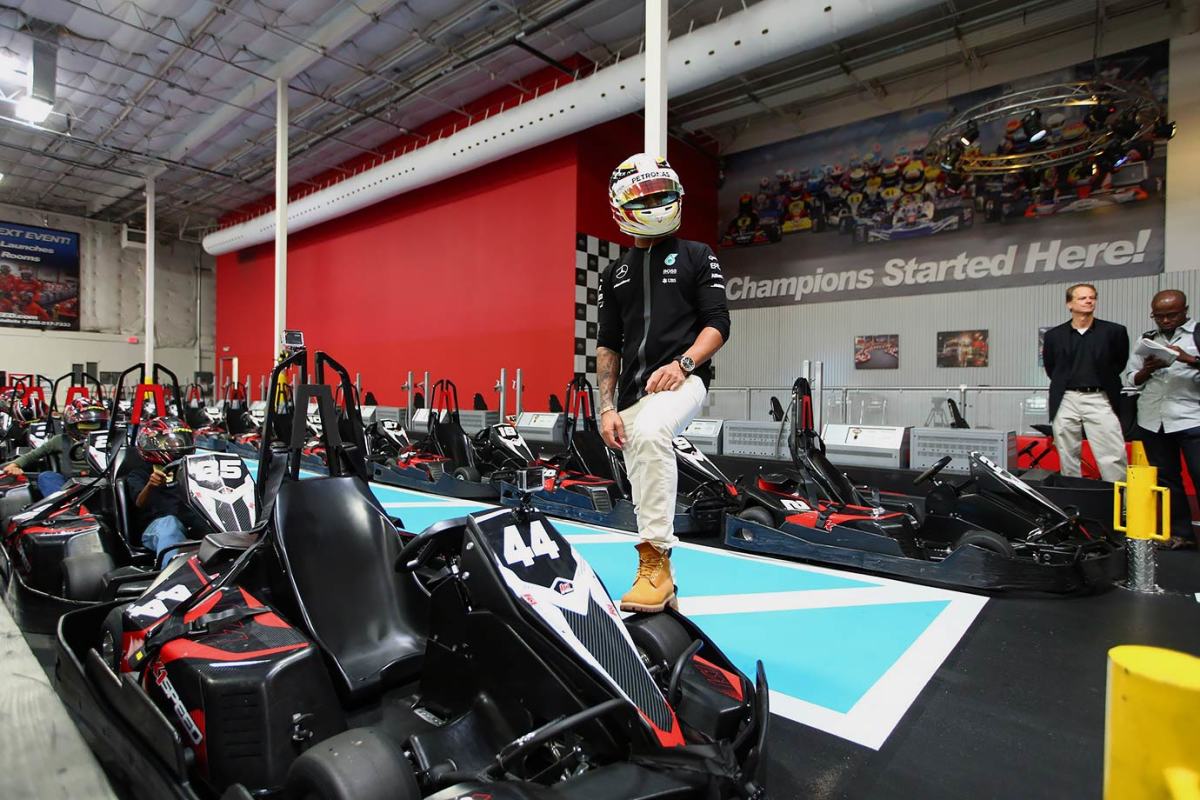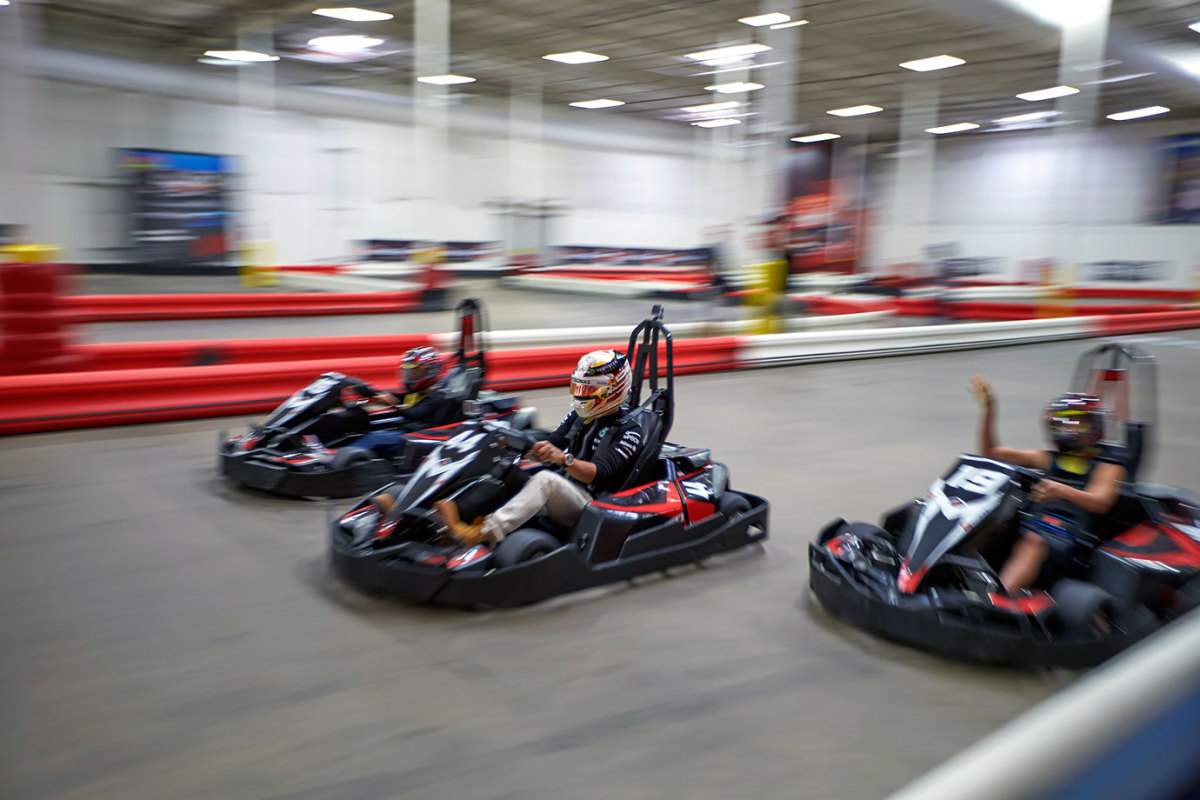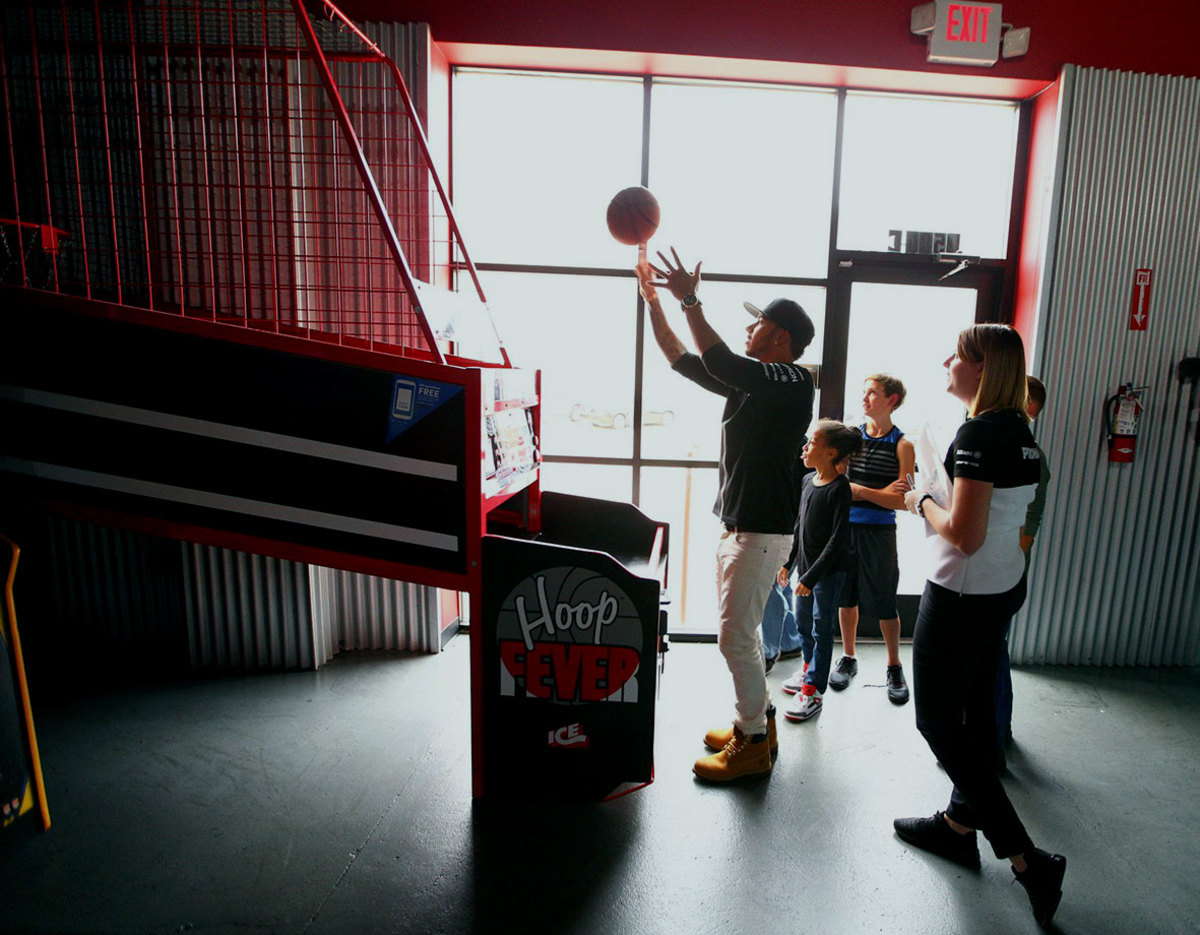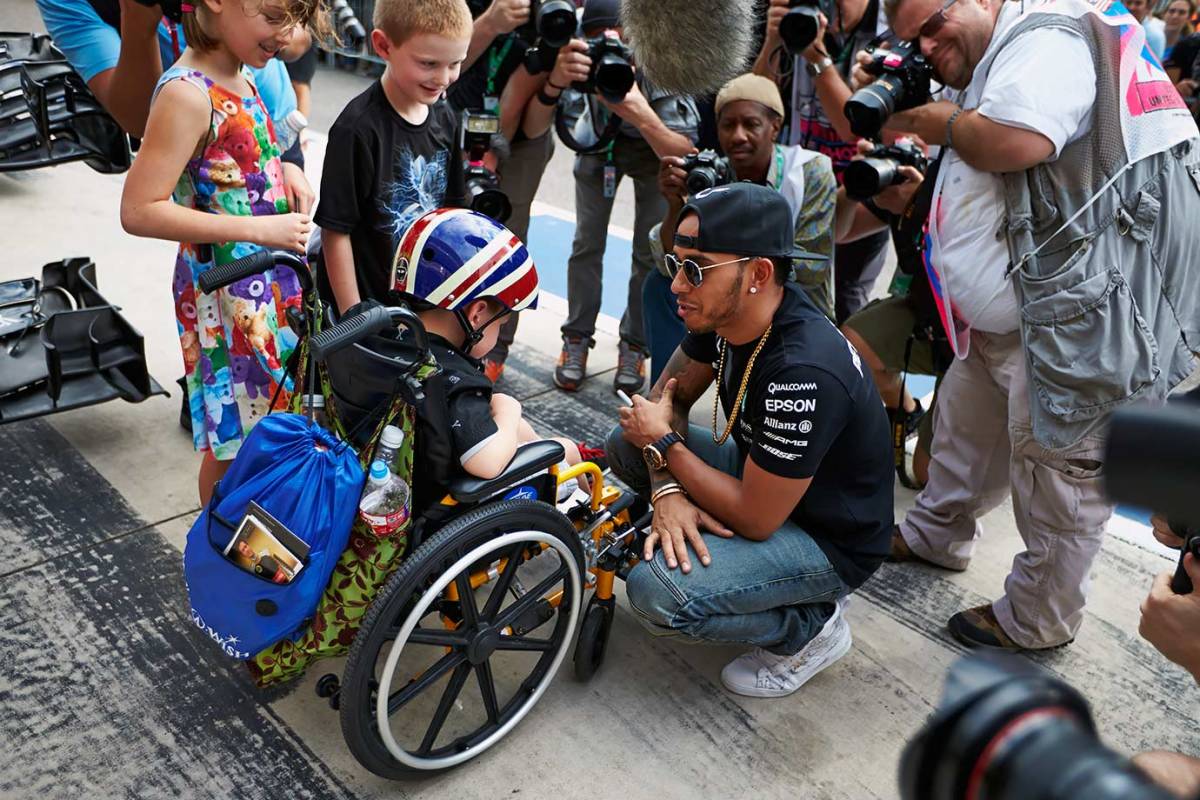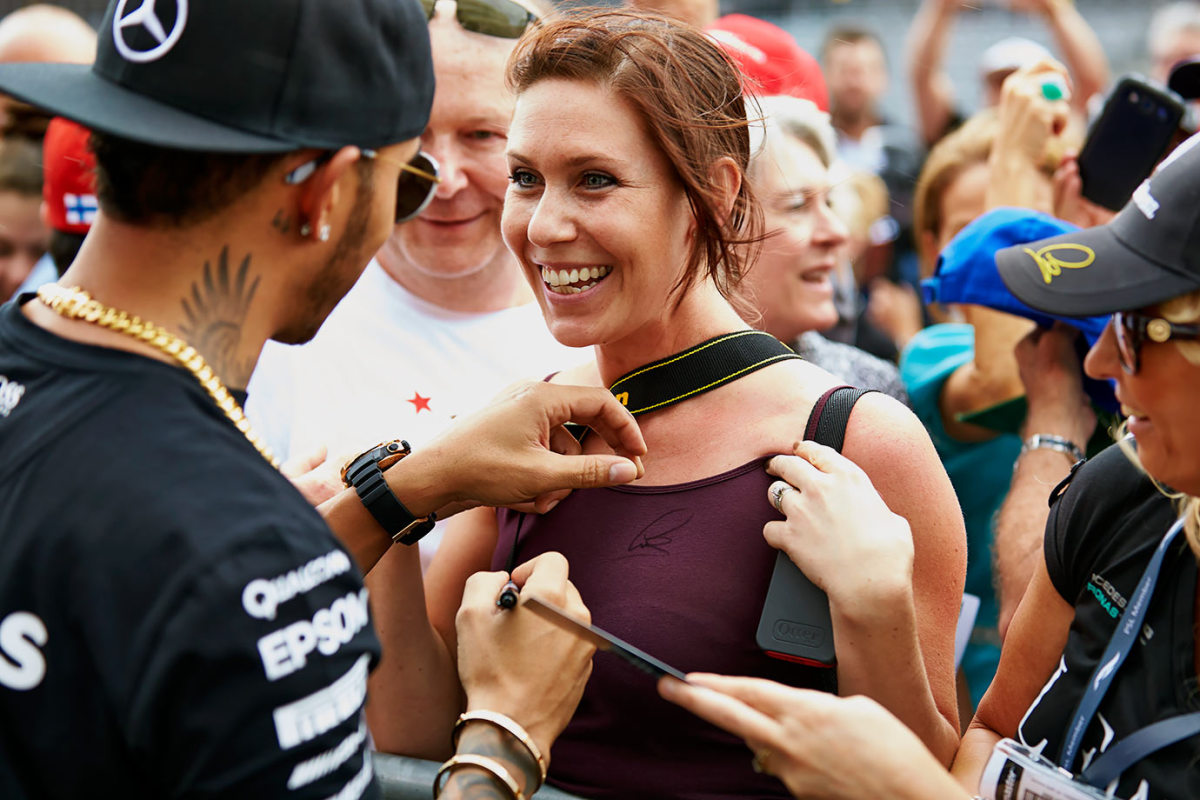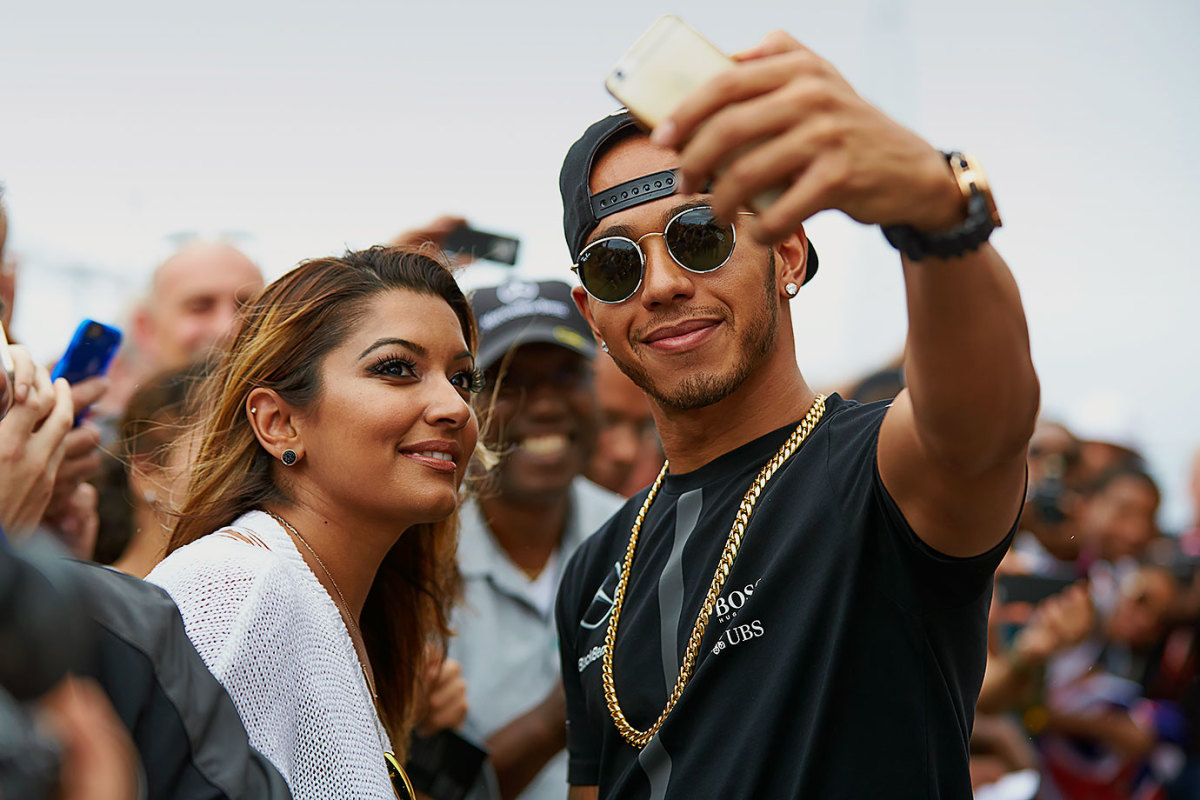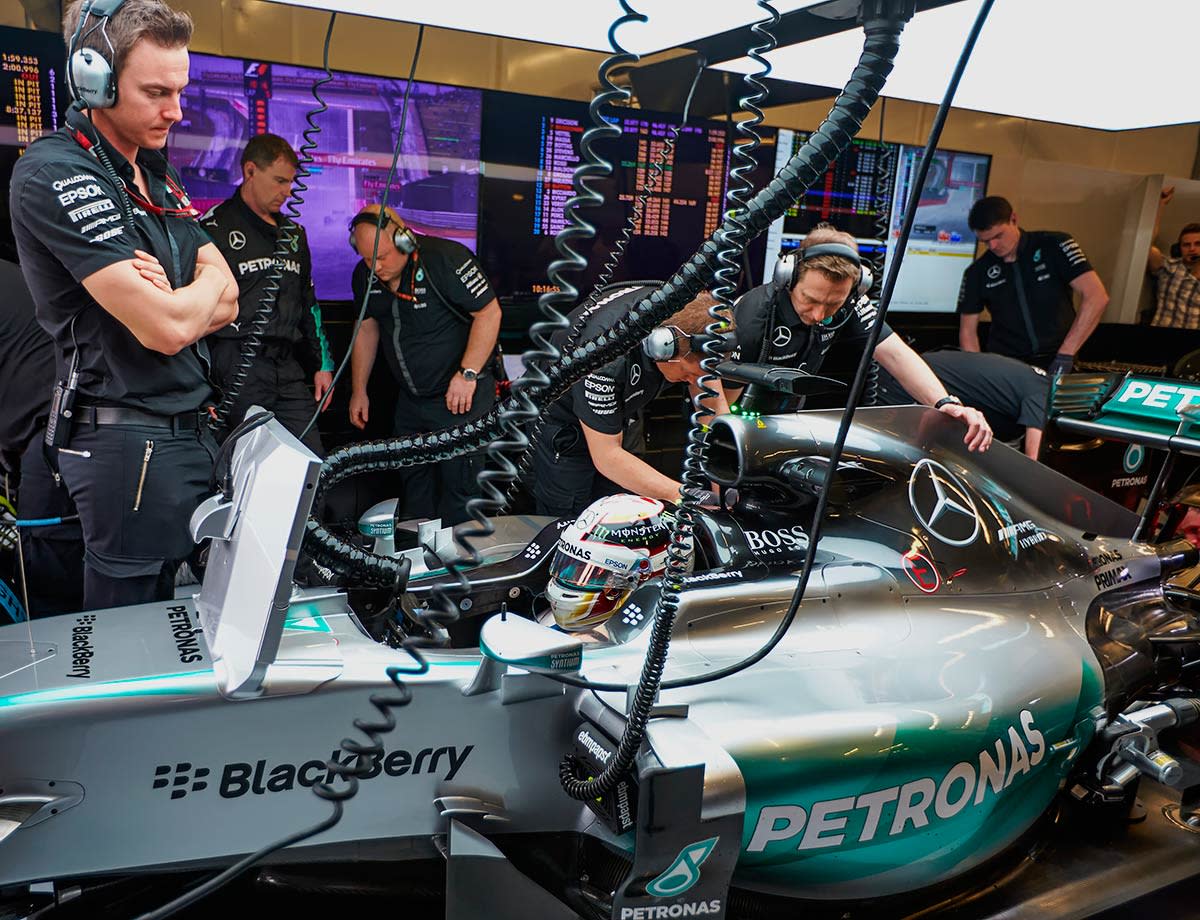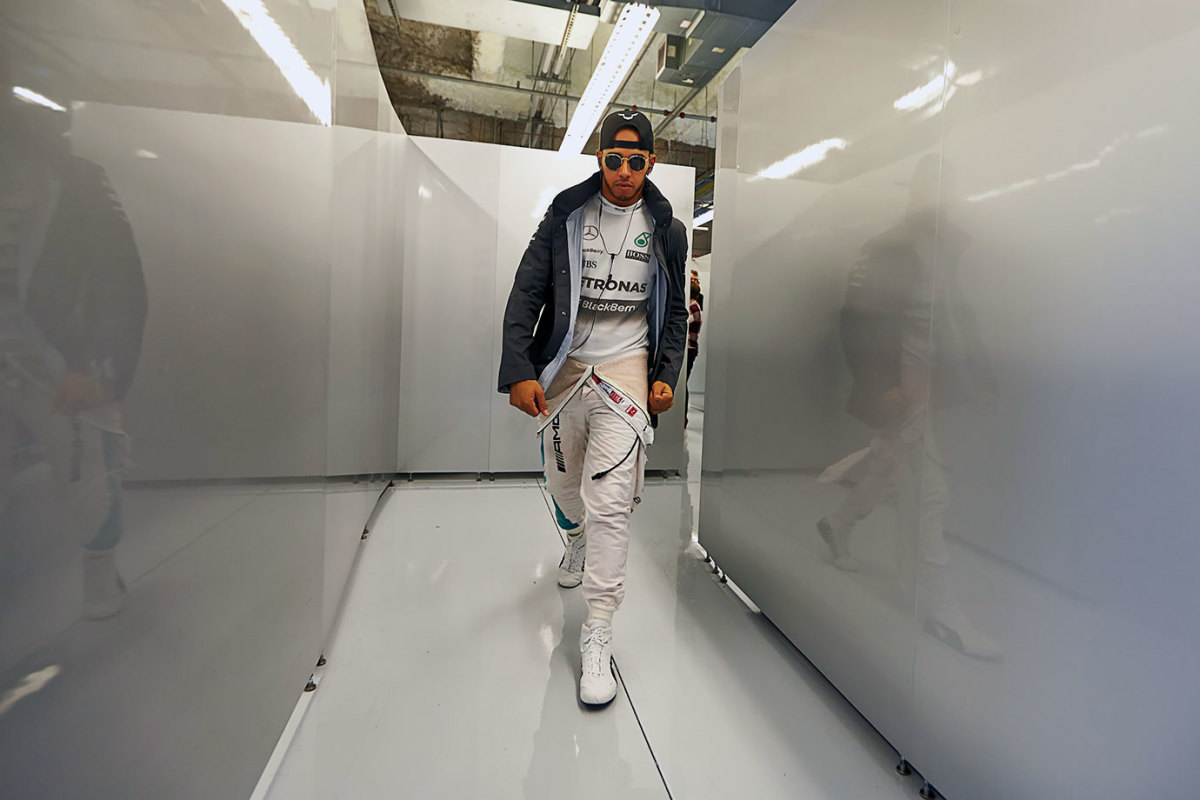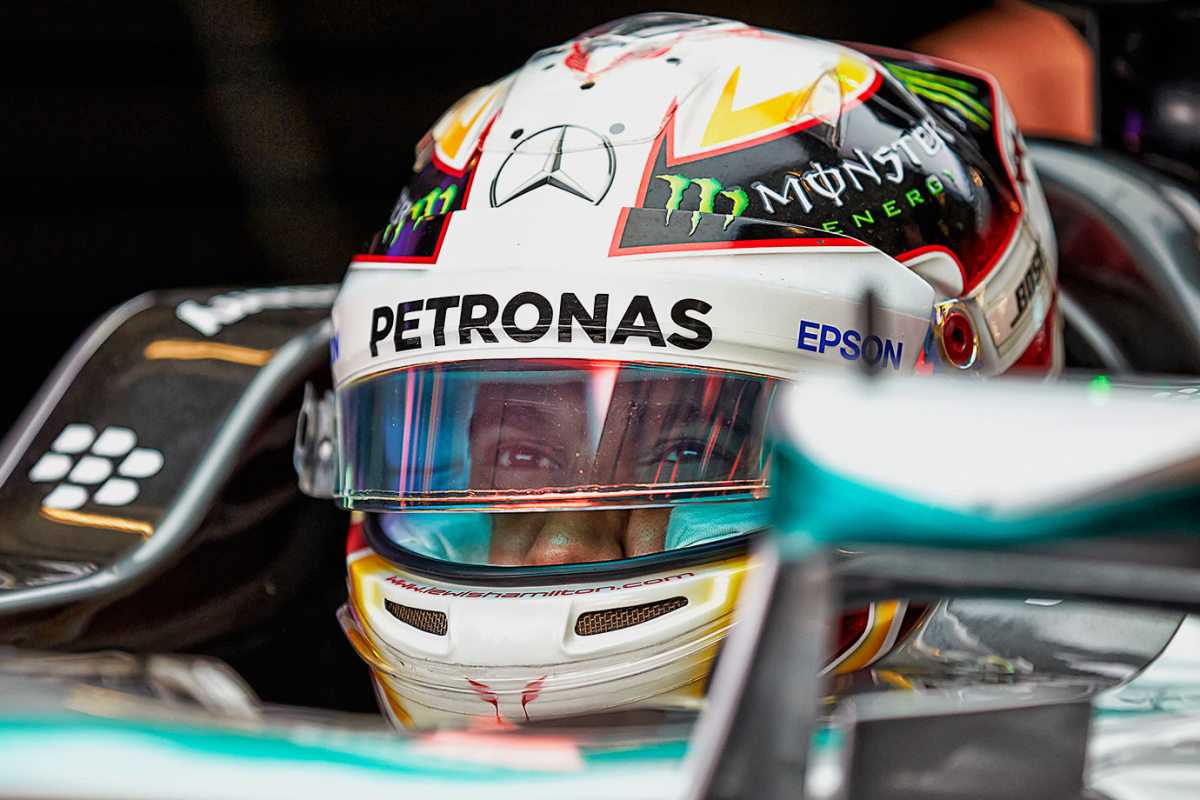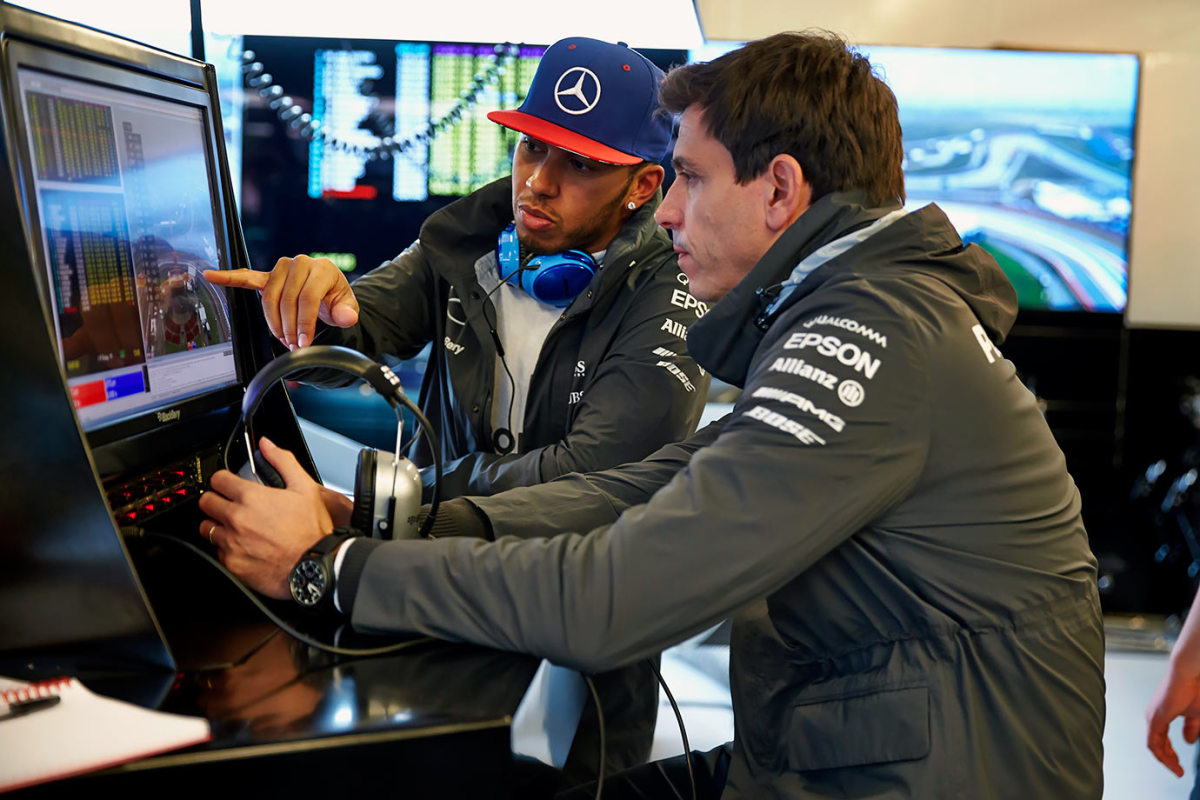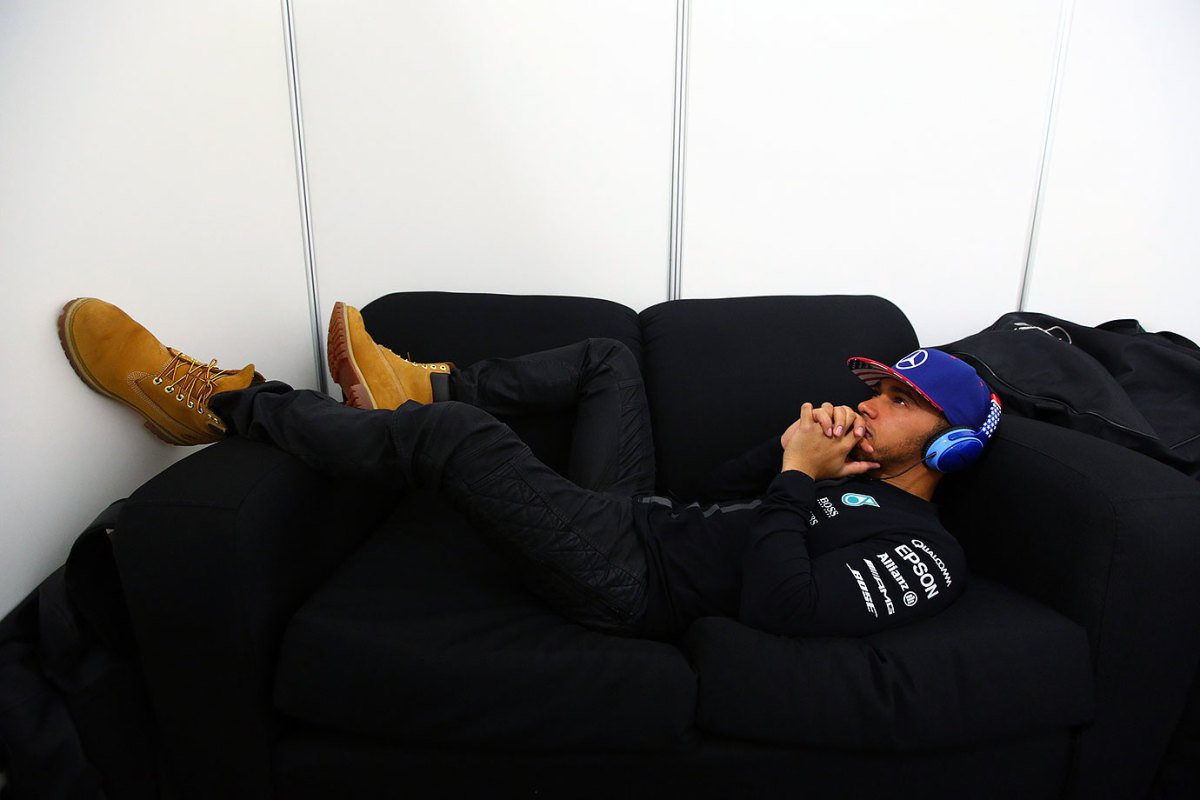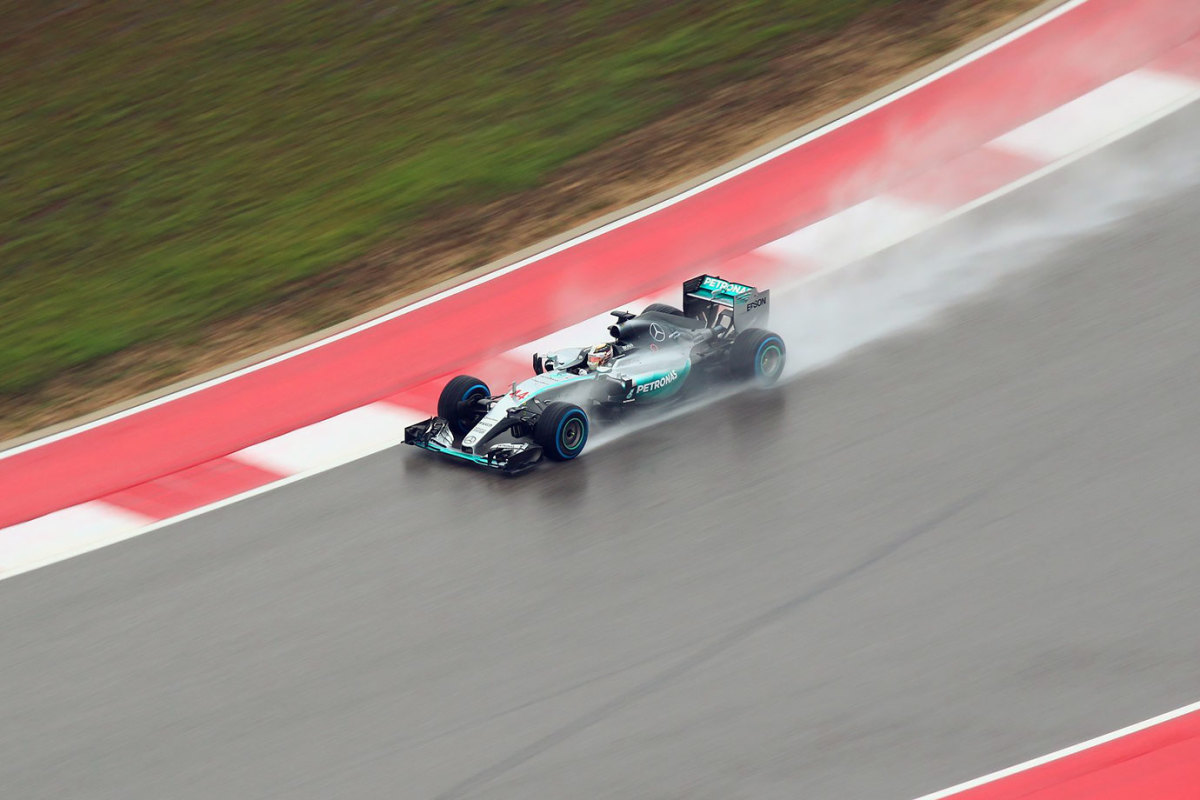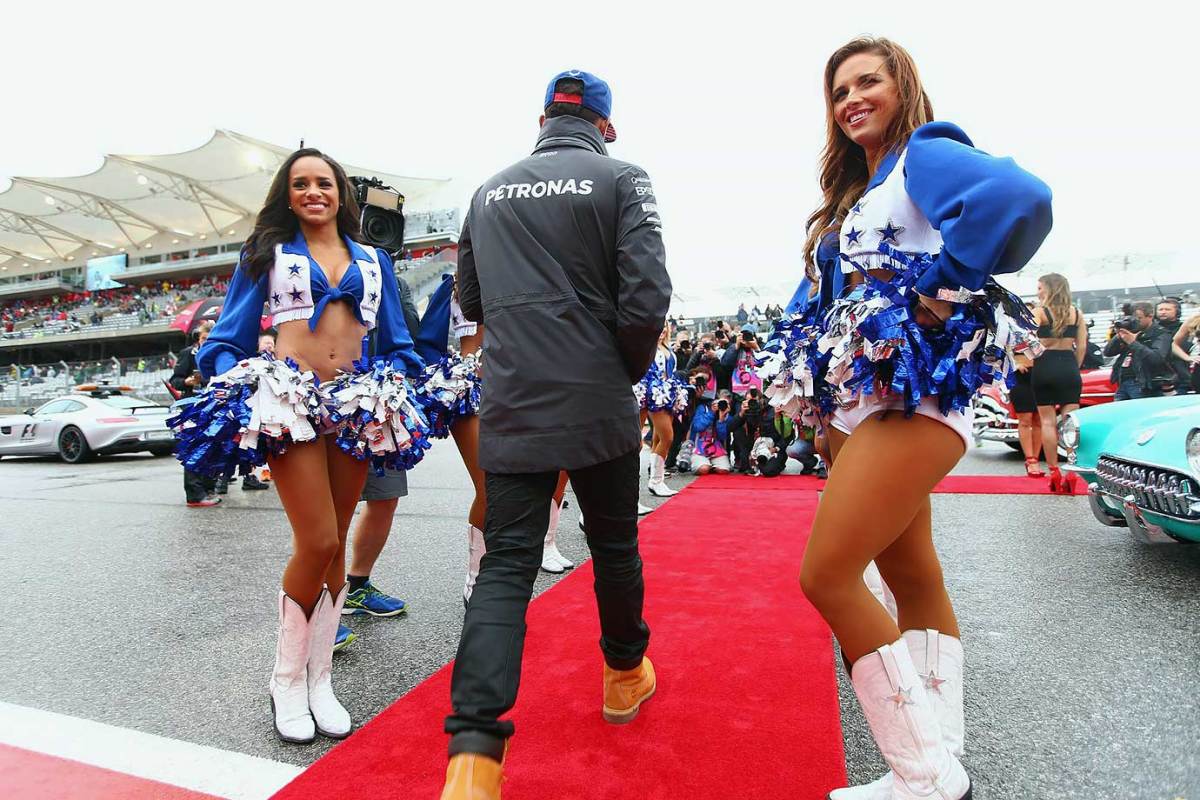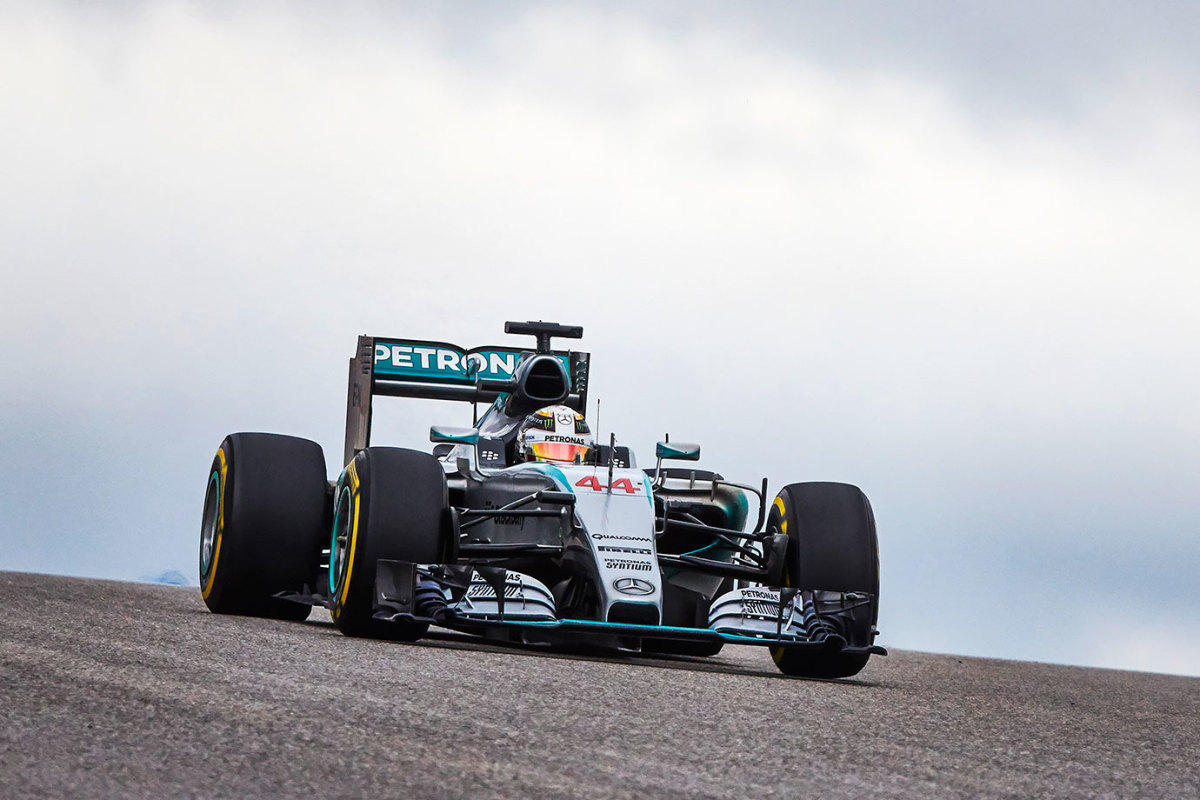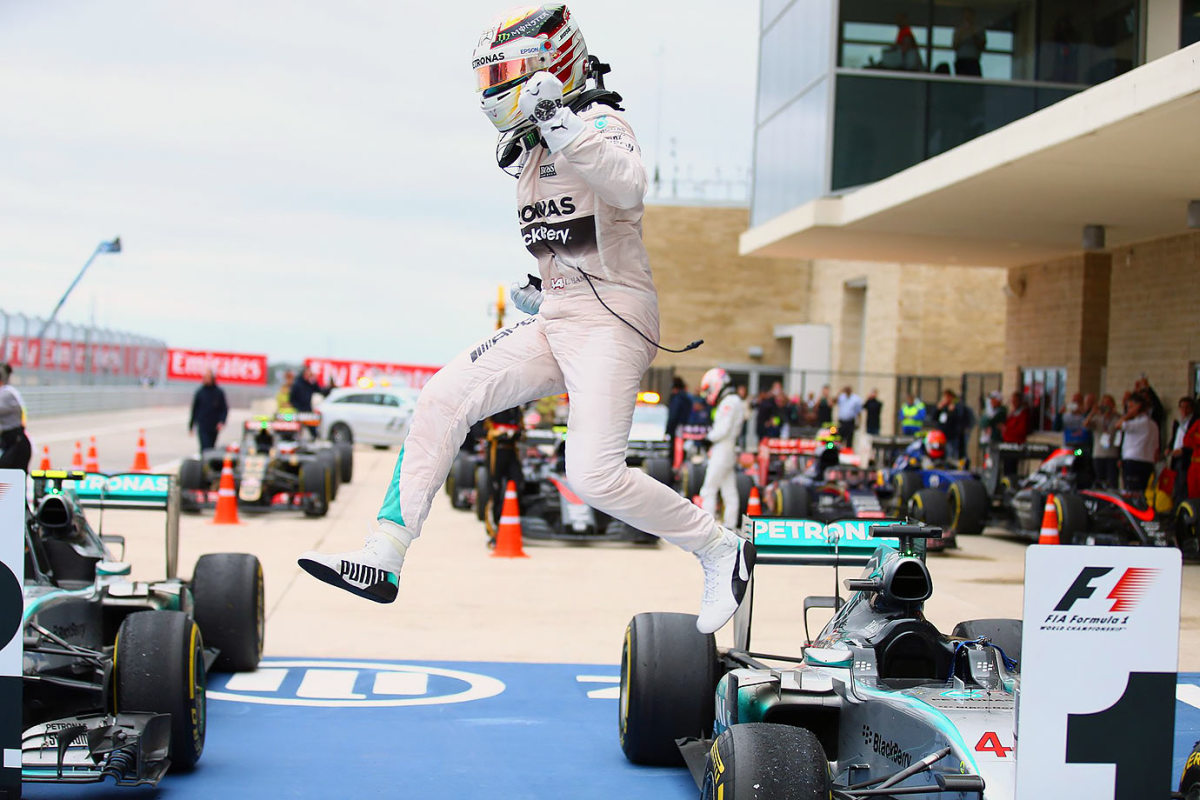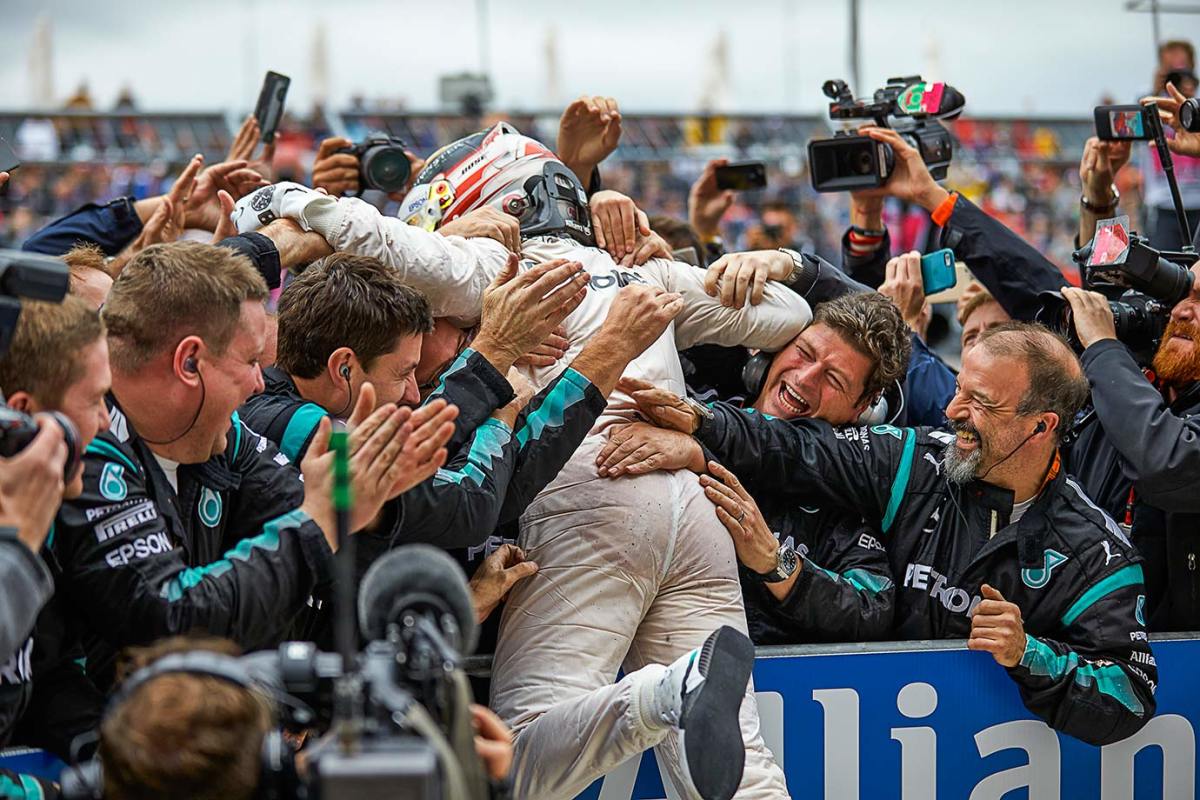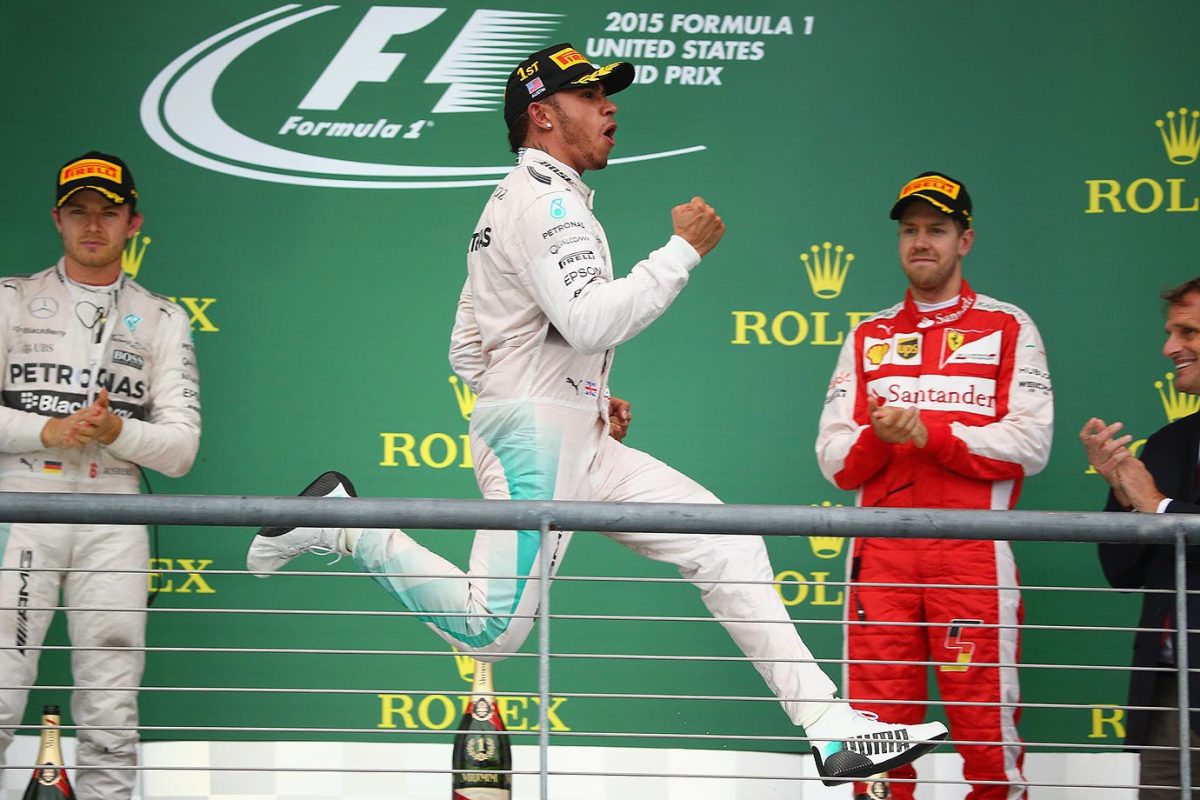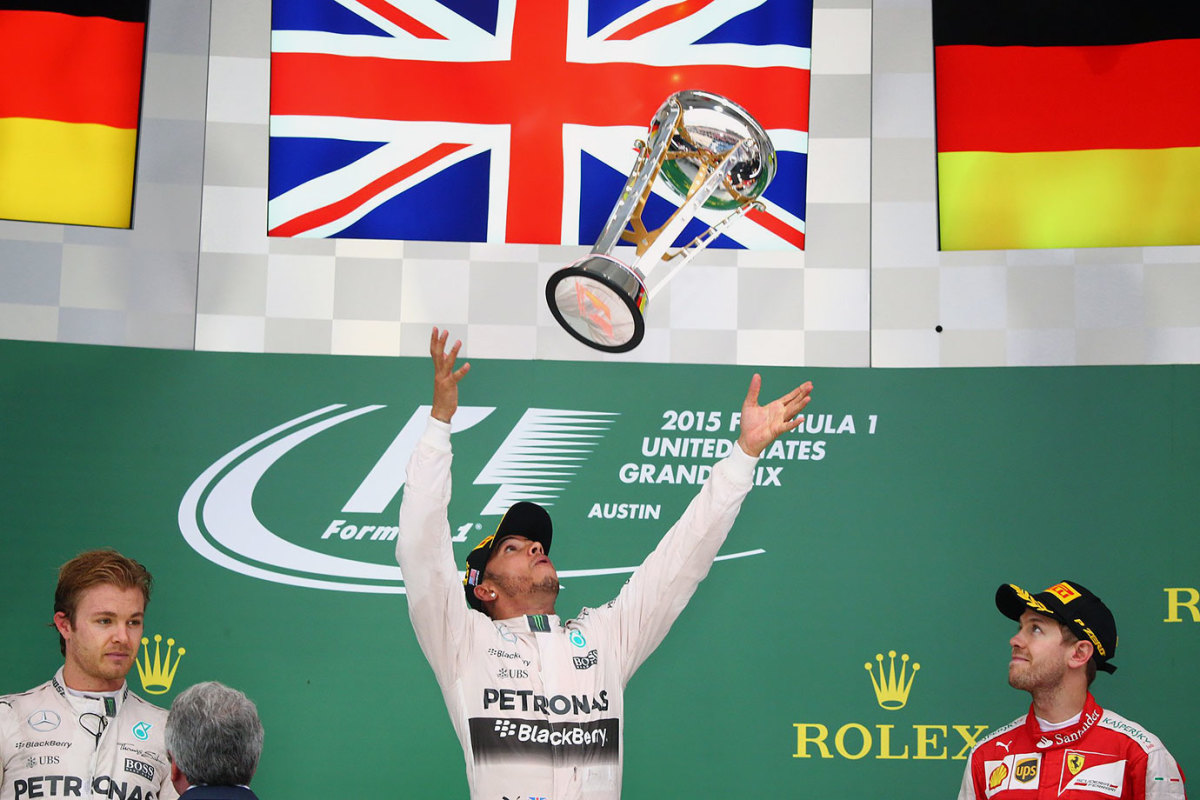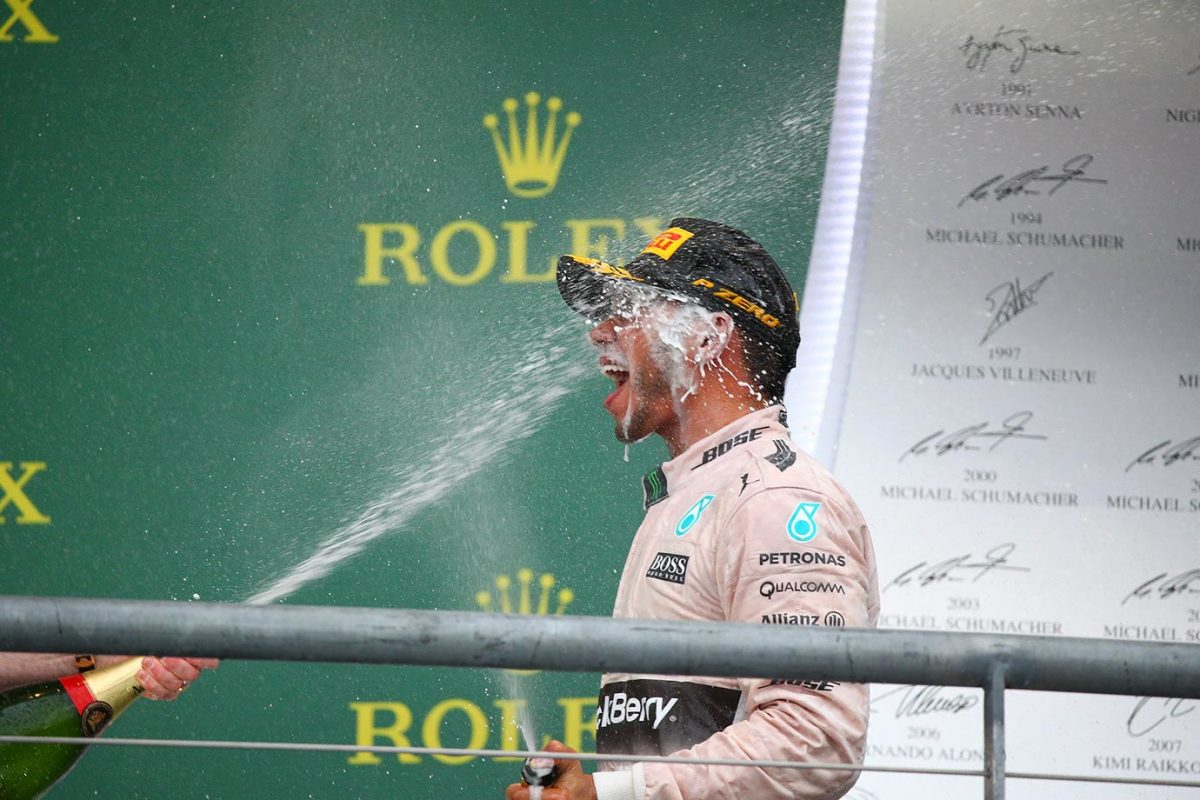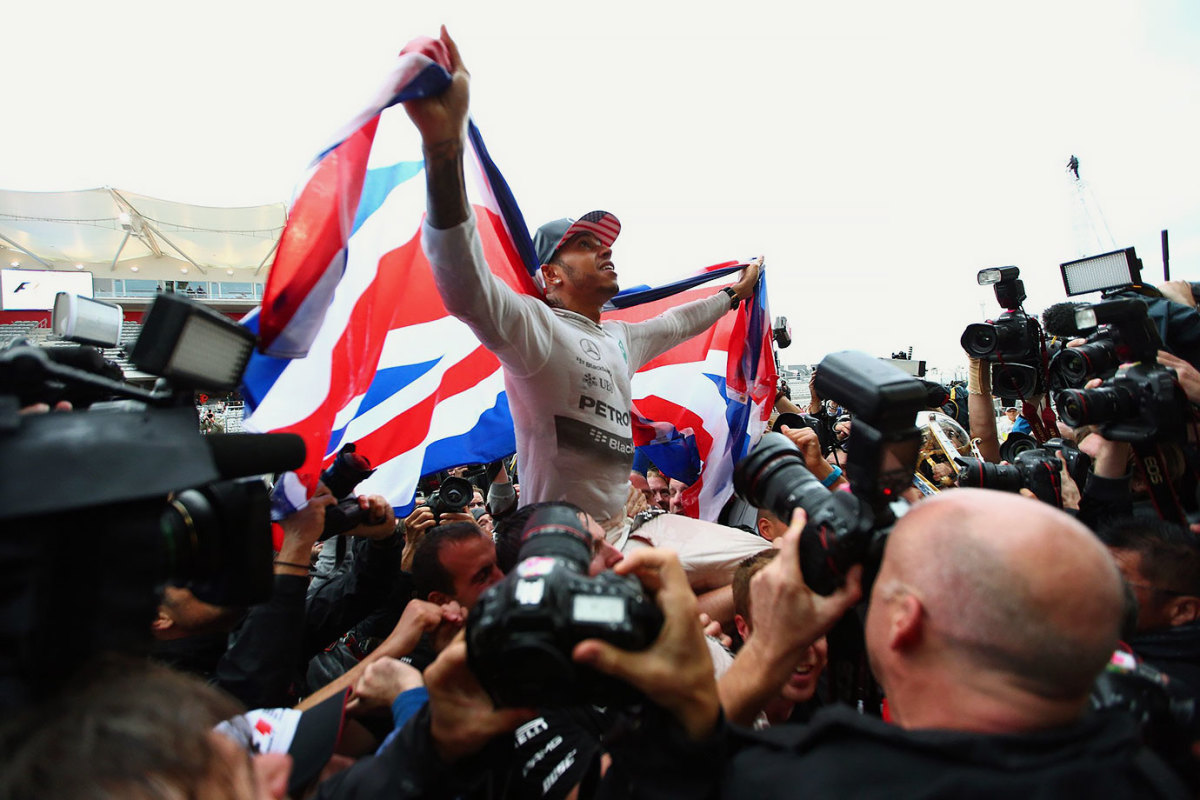F1 champion Lewis Hamilton is a crossover star with gravity

AUSTIN, Texas —They were cute kids. Healthy kids. And so cool and collected for a quartet that had cut school for the chance to spend the afternoon at an indoor go-kart track hanging with a real Formula 1 driver, five days before the U.S. Grand Prix here. When Lewis Hamilton swaggered onto the scene in his flat-brimmed baseball cap and sponsor-studded tee, wearing low-drop jeans and Timberland boots, and covered in a bounty of bling that ran from his earlobes to his wrist, these kids jumped right in with the questions.
When did you start racing? As an eight-year-old, he replies, to their great surprise.
“I guess I missed my chance,” a 14-year-old boy named Ethan would say later.
“I thought you could start at 18, 19,” added a precious nine-year-old girl named Kaelyn.
How many championships have you won? “I’ve never been asked that question,” Hamilton starts. “In Formula 1, I’ve got two and I’m working on my third. But I’ve won championships since I was eight. When I was 10 … 11 … 12 …13 …” Slowly, the 30-year-old Hamilton extends finger after finger until he’s counted up to 20, and this bugs the eyes of a 10-year-old named Travon. (“Off the chain” was how the boy eventually summed up Hamilton’s title streak.)
How did go-karting affect your F1 experience? “It’s like going to school,” Hamilton explains. It’s where he learned a feel for racing, how he now is able to turn a 900-horsepower road rocket into an extension of his 5' 9" frame. “And that’s why I can overtake people, no problem.”
Last question: Will you race with us? Pleeeease? You bet, Hamilton says with a bright, gap-toothed smile, “but take it easy on me!” And with that, the kids scattered to a line of electric karts. Hamilton helped them buckle in before slipping on his actual racing helmet—a giant Jawbreaker of a thing with the phrase STILL I RISE writ in large cursive on the back—and climbing into a black and red-trimmed kart at the front of the cue bearing the number 44. It’s the same number as the one on his company car, a silver and green Mercedes.
Once the karts are booted up, the drivers are told their race will run two laps. “Two laps?!” Hamilton says as he leads a whirring procession out of the pits. Fine, says a grown-up in charge, just keep going until we wave you in. The green flag flies, and the karters speed off into a kinky 1/4-mile circuit; to Ethan’s young eye, a few of the track’s turns seem near copies of the Snoopy-snout bends that are distinctive to the F1 track in Barcelona. “Yeah!” says Hamilton, who came in second at a Grand Prix there earlier this year. “I see it…”
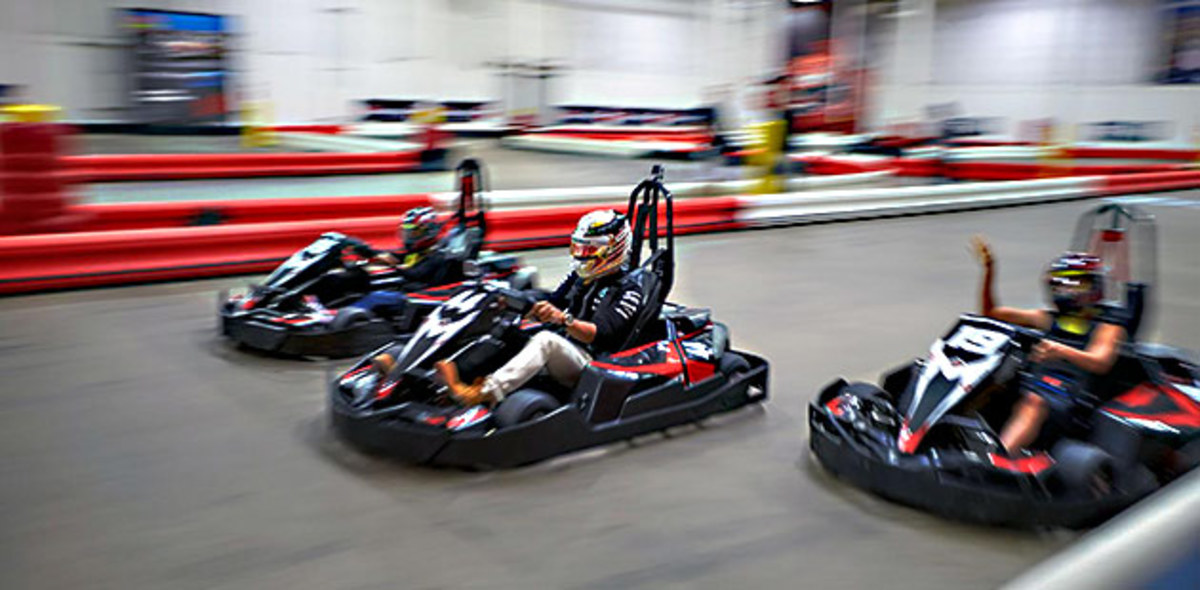
Hamilton keeps the lead for a few revolutions. But then he gets caught up behind Kaelyn, in lap traffic, and licks the barrier. The procession zips past, led by a 12-year-old boy named Grant—a NASCAR fan, he later sheepishly confesses.
Hamilton’s scrape doesn’t bring out a caution flag, which is easily enforced on this electric circuit by remotely reducing the power on the karts. But it does take the F1 ace out of contention. If this deflated Hamilton, he certainly doesn’t show it while power-sliding his kart in pursuit of the pack—leaving Grant far ahead to claim the checkered flag.
After pulling back into the pits, shedding their racing gear and lingering for a beat in the afterglow of a good time had by all, Hamilton and the kids repair to an off-track lounge for a round of Pop-A-Shot, then on to a private room with a giant projector screen to play F1 2015 on Xbox. Watching the young Englishman engage with an even fresher faced American audience in his own biracial image, you could almost forget this moment was being captured by a Spanish-speaking film crew. You could almost forget that these kids—with their incisive questions and their knack for taking direction—came through acting talent agencies, that they were working a plum gig for the Japanese electronics company, Epson—one of Hamilton’s many, many backers. (Their reimbursement: $100.)
You could almost forget that this is the reality of Formula 1, a world at quite a remove from our own. Chalk this subtly manufactured moment of authenticity, brought to you by Epson, as an instance in which Hamilton was caught in the space between. Given how often he moves between worlds, it’s a wonder he isn’t caught out more.
The top guns
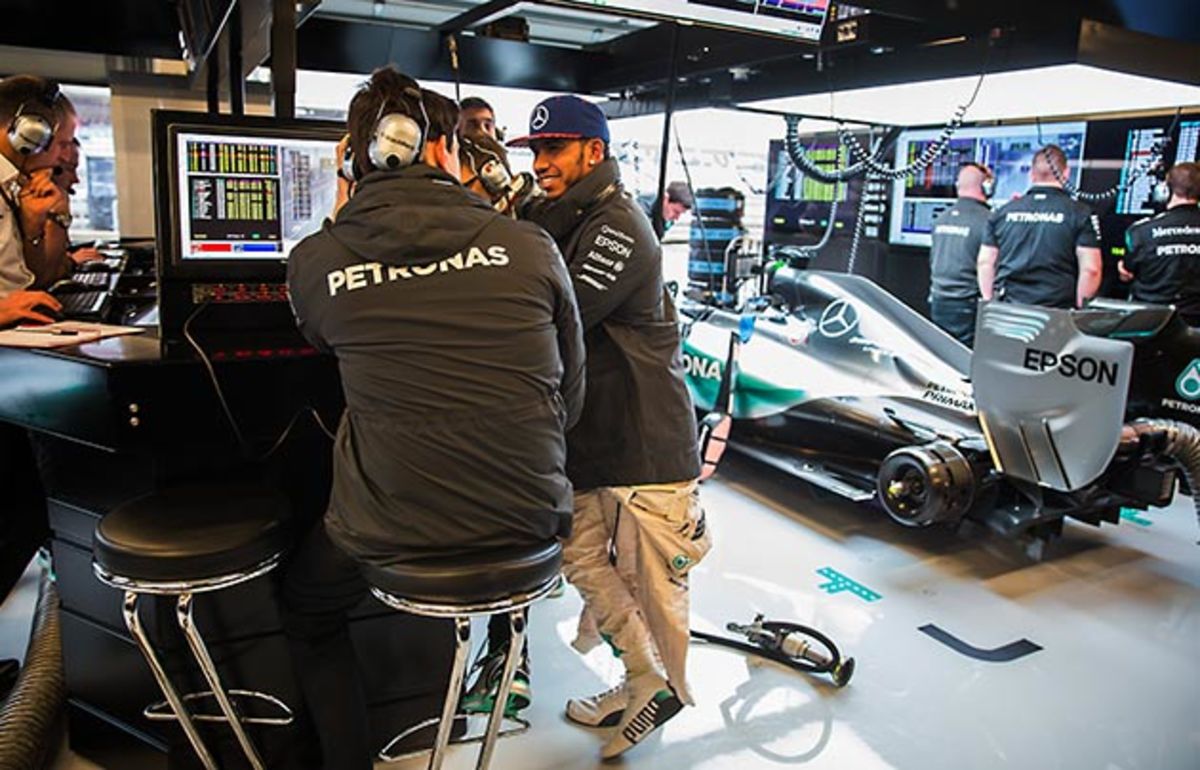
Formula 1 is a foreign country; they do things differently here. They chase the sun. They use the metric system. They speak in strange accents that put funny spins on terms like “pace car” (safety car) “racing team” (constructors) and “chicane”—which, geez, doesn’t even translate to us curve-averse Yankees. Of course, this is when the natives are speaking at all. In the world of F1, loose lips sink constructors, which jealously guard the ingredients that make their cars go.
Really, the only thing more precious to this world than secrecy is money, a vastly more abundant resource as it turns out—one measured in the hundreds of millions. But the filthy lucre is quickly sucked up by all the research, development, and labor that go into building the earth-bound rockets that these constructors are constantly pointing at each other. Oh, don’t get it twisted: Theirs is a serious arms race. It demands serious fighter pilots, truly brave souls who aren’t afraid to throw their priceless machines around some of this planet’s loopiest outcroppings at nearly twice the speed of a Randy Johnson slider.
“When you’re going 180 mph or whatever on a straightaway into a hairpin turn, you just have to be fearless,” says Johnson, who has gone from raining knee-buckling fireballs from the mound to snapping pictures of musicians and landscapes as a globetrotting photographer in Big League retirement. Shooting a Formula 1 race had been on his assignment bucket list for some time. An exceedingly rainy weekend in north central Texas would not dampen his enthusiasm. “If you want something bad enough, you have to push the limit sometimes—within reason, I guess—in anything you do,” he continues. “And these guys really do that, especially in these conditions. I have a great appreciation. I’ve watched it on TV, but now when you’re in person it’s considerably different.”
F1 drivers are the top guns of motor sports, an active company of about 20. The average person has better odds pulling off a Vegas casino heist than getting even a sense for the rarified air these drivers breathe. “People can’t relate to it,” Hamilton starts. “If you’re like, Hey, Formula 1 looks cool! I’d like to try it! Impossible. Most likely 98% of the world will never get in a Formula 1 car. Or get in anything that comes close. If I said, I wanna play like Michael Jordan, I could go dress in all his clothes and his kicks and play right now. I would never play like him, but I could go and try. I can feel like it. You don’t get any of that in Formula 1.”
Even other elite sports figures have little sense of the athleticism that underpins F1 engineering, where the difference between four pounds and eight can be several hundred thousand dollars. But the driver’s fitness is scrutinized as much as the car’s. “I was talking to Serena Williams the other day,” Hamilton says, “and she’s like, ‘You have to train? To keep fit?’ I’m like, Yeah. Let’s go training. I’ll probably most likely run you into the ground.”
He’s convinced that he’d easily run rings around any of the good ol’ boys in NASCAR, too. “I met Tony Stewart for [a racing exhibition], and we got changed in the room,” Hamilton says. “Took his top off and he was ... big. For a driver. I was really surprised. I didn’t know it was like that because I’m cut, man. I’ve been on a diet all year long. He had been to McDonald’s probably that morning, you know? If he tried to do five, 10 laps in my car, he would not have made it most likely.”
Purest of rivals
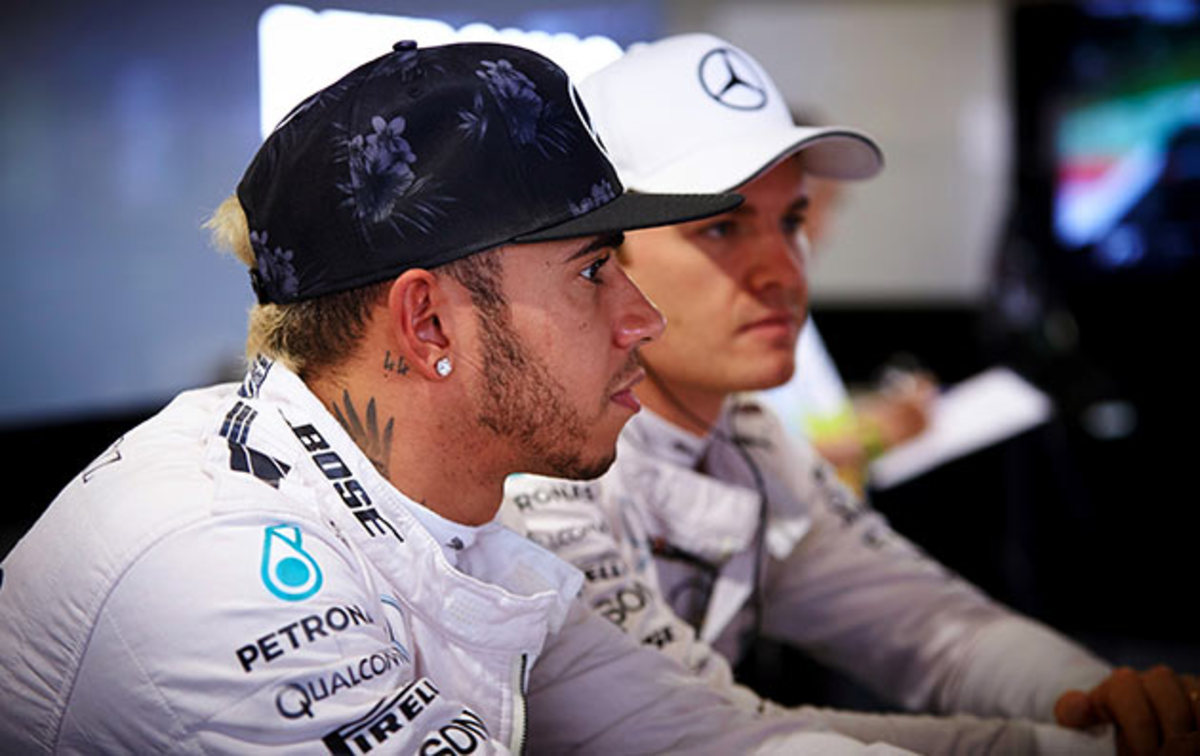
Earlier? When Hamilton was casually ticking off his awesomeness for the kids? Believe it or not, he was actually understating the fact that he is, without question, the very top of the top guns—one who won’t hesitate to take a shot or 70 if given even the slightest opening. When he said he had won two Formula 1 championships, he left out the part about being a record 23 years 301 days old when he claimed his first title (in 2008). And the part about reestablishing a constructor that hadn’t fielded an F1 team for more than half a century when he won the second crown (in 2014).
Heading into the U.S. Grand Prix, which since 2012 has been showcased inside a place that bears another funny name fit for translation, the Circuit of the Americas, Hamilton had 42 victories. That was more than any other Briton, more than the great Ayrton Senna, more than a driver with barely a decade’s experience should rightly have. And another thing, Hamilton says, “My teammate doesn’t let me pass him to win races.” Mark that down as a somewhat veiled shot at Michael Schumacher, the seven-time titlist who serves as this world’s Greatest Of All Time.
Hamilton uncorked that shot at Schumi four days before the USGP, while sipping on a lemon Pellegrino from the comfort of his Mercedes team hospitality suite—a shed to rival any W Hotel lounge. At the time, he was already a staggering nine victories to the good through 15 races in 2015. In his other six starts, he had finished lower than third just twice. All of this gave him a lead of 66 points in the standings and a chance to, well, finish “working on my third” championship with three races left on the calendar. He only had to finish nine points ahead of the second-place man, a witty German named Sebastian Vettel who drives for Ferrari; and nine points ahead of his teammate, a multi-lingual Finnish Deutscher named Nico Rosberg. A tenth win would more than settle the score. But it could just as easily start something, too.
That’s the other secret F1 keeps: The enmity between their drivers is something fierce. The constructors, by turning their points into the real object of this championship, made this so. They don’t care so much about how they score, but they know that an internecine rivalry can only help their numbers—as long as no cars get hurt in the process, naturally. They cast the die for the Hamilton versus Rosberg rivalry.
You could call Rosberg the Drew Bledsoe to Hamilton’s Tom Brady—that is, if Nico weren’t racing for a Formula 1 juggernaut that sprang from his own country, or the son of 1982 F1 champion Keke Rosberg. On top of that enormous pressure, Nico Rosberg has had to reckon with Hamilton, who has been taunting him since go-kart days. Because of their long history, the two tend to get on like brothers—friendly to each other one minute, pushing each other’s buttons the next.
This is one reason why theirs is the purest rivalry in F1. Another is the fact that Mercedes, an absurdly rich constructor with the most dominant engine on the grid, gives them exactly the same assets to work with. “Every single thing that’s done on my car is either mirrored in the other car or [Rosberg has] the option to mirror it,” Hamilton explains. “So for example tomorrow, we will start with identical cars. Our engineers, we sit like this”—across from one another, at a long wooden table—“and we do our debriefs. They hear everything I say. Every change he makes, I see. Every change I make, he sees. All the data, all the reasons I’m quick he will see, and vice versa. It could not be any more transparent. So we do work together in terms of moving the team forward. And then obviously you want to win.”
The hard sell
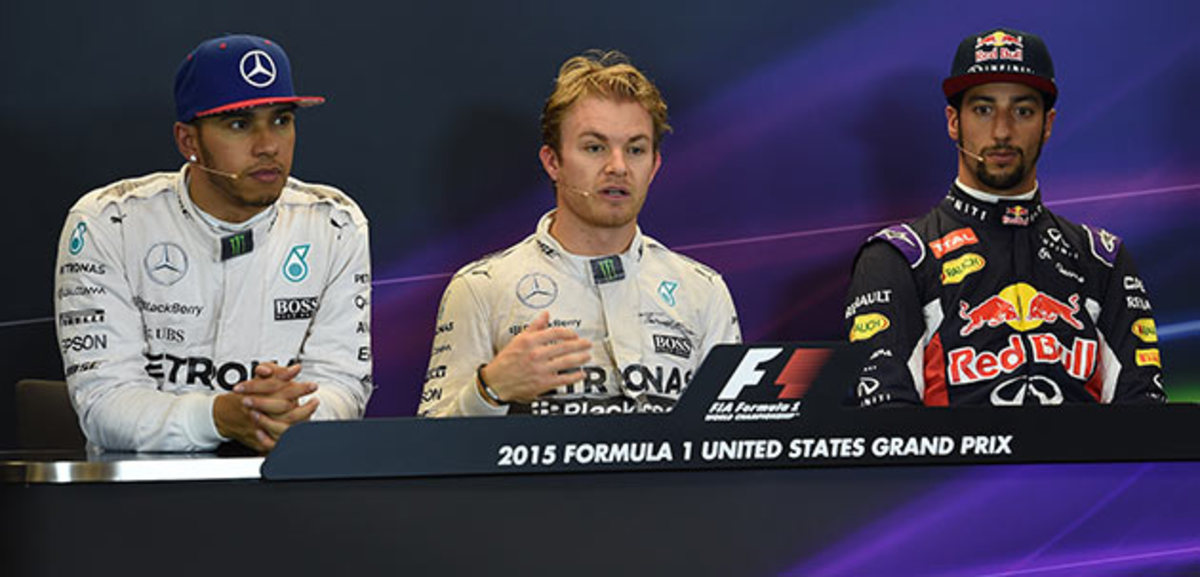
The climate outside Mercedes hospitality is somewhat less taut, but only just. Some of that tension was revealed just before Hamilton kicked back with his fancy lemonade, inside the racetrack’s press conference room. Over there, he sat with five other drivers; they were arranged in two rows, three abreast—like U.N. delegates inside the General Assembly Hall. A moderator took up the first 10-minutes of the half-hour session. His second question was to a 26-year-old Australian driver for Red Bull named Daniel Ricciardo.
A third-place finisher in both last year’s U.S. Grand Prix and in the ’14 points standings, Ricciardo had fallen on fallow times recently, dropping to eighth on the table. With that as a preamble, the moderator asked: How much would it mean to finish ahead of the seventh-place man, Daniil Kvyatt, your teammate? Ricciardo went on to answer the question diplomatically and enthusiastically. No one blinked at the setup.
To survive rivalries that are constantly stoked, the drivers seem to turn a touch cold—to the point of coming off robotic at times. This too was apparent at the Thursday presser. When one driver would engage a questioner, the other five would bow their heads—looking not unlike members of Munch’s Make-Believe band. Even Hamilton holds a long downward gaze in this space, the flat brim of his cap covering almost all of his face. That is, until an older, bespectacled African-American gentleman in the crowd named Kwame Lillard asks the panel what they could do to “create more enthusiasm in urban black America for Formula 1.” At this, Hamilton’s head rose and his face brightened. “Don’t look at me, ask these guys first,” he said, flashing his Cheshire grin again. “I’d love to see what others think!”
Again, Ricciardo—who, bless him, can’t hide his Labrador retriever-like personality—leaned in. “Just try and be as lad-sy as possible,” he offered. “I think as drivers most of us try to be y’know, like … cool people, funny people.” Understand: This is a driver who, two days later, would grab Kvyatt at the hand and waist and waltz around with him in the Red Bull pits for the fans’ entertainment during an extend rain delay. “I don’t know if I’ve answered your question.”
The next stab at the question went to Alexander Rossi, a serious 24-year-old whose claim to fame is being the only American to hold a current FIA Super Licence (translation: the certificate that makes a driver F1 road worthy). To score that permit, Rossi moved from California to Europe when he was old enough to drive a regular car in order to take aim at top gun. The U.S. Grand Prix would mark his third ever F1 start. “Obviously motor sports is something that is quite difficult to get into—that’s the same for any young kid trying to do it. I think the biggest thing is a direction where to go. There’s always things that can be done in terms of making it expand to a different part of the States. Once that happen it’ll appeal to a much broader mass.”
Then came Hamilton’s turn. “It’s difficult for people to get attached here in America. … Maybe Formula 1 can start to engage more with the NFL or with other sports. I never, ever see an NBA player come—I’ve had a friend come once. Otherwise it’s never really been anyone from those sports, different kind of sports, come and try to see what Formula 1’s about, to maybe bring some attention to it.
“As you can see, I’m doing as much as I can—but I’m only one person. Yesterday, I went go-karting with some kids. There were two black kids with us. One passed me, the first time I’d ever been on a track with a black kid and, coming past it was like seeing myself come by. It was kinda funny. It was good.”
F1's rock star
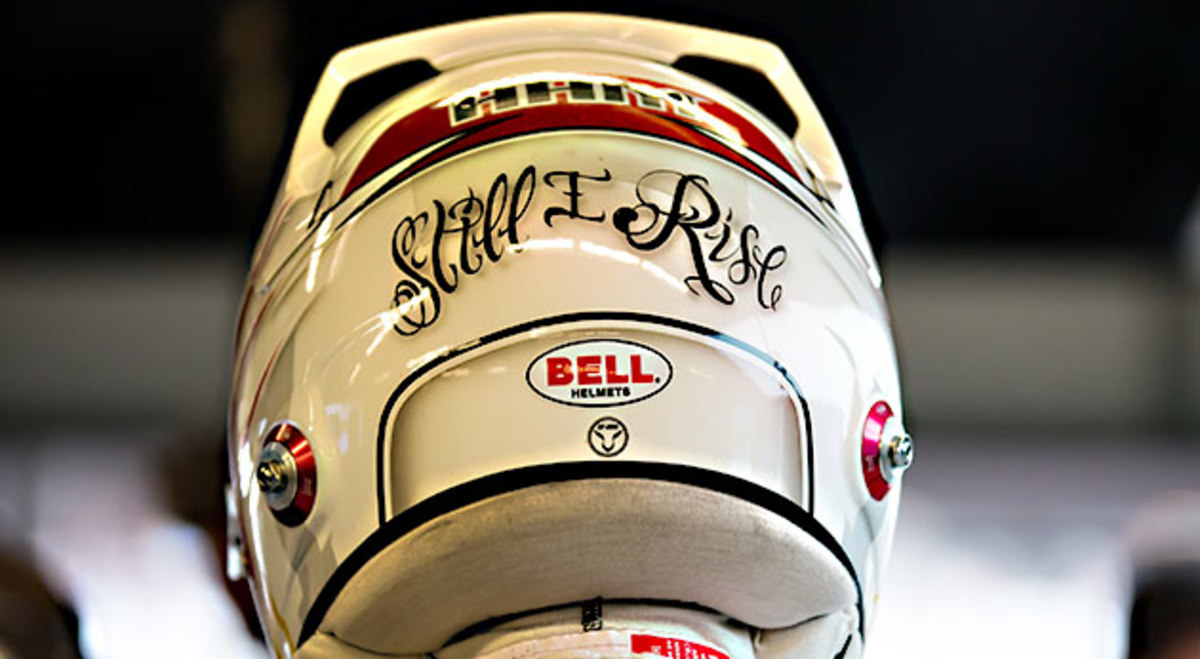
Hamilton does not have to try hard to make F1 appealing. In addition to being young, handsome, charismatic and—this is the crucial bit—F1’s alpha dog, he is also deeply ensconced in the American Celebrity Complex. He keeps home bases in South Beach and Colorado. GigiHadid, the SI swimsuit model, is a pal; he recently turned up at New York Fashion Week in support. Nicole Scherzinger, the only member of the Pussycat Dolls folks can reliably name, is Hamilton’s on-again, off-again girlfriend. He even has a lapdog, a bulldog named Roscoe—the unquestioned star of a social following that numbers in the millions.
Jay-Z is a friend of Hamilton’s, too. Actually, he’s been trying to sign the racer to his label for almost a year now. Therein lies another fun fact about Hamilton: he makes music, a mix of hip-hop, R&B and pop—enough to “give out, like, 10 albums, I have so much music,” he says. He makes it for his own catharsis, not for record sales or for a mass audience. Still, to hear the positive reviews from Hamilton’s private listening party—people like Drake, Janelle Monáe and Kanye West—Hamilton’s stuff certainly sounds worthy of wider airplay.
Just this past Easter, West invited Hamilton over to brunch with his family. The long afternoon of mirth and merriment by the pool nearly drew to a close before Hamilton finally worked up the courage tell West, “I would love to send you some of my stuff, man, just to get your opinion on it.”
“Can’t you just play it now?” the rapper insisted.
The line hit Hamilton like a punch to the gut. “I was like, uhhhhh … O.K.,” he says. “And then right next to the pool where everyone was, he opens up the pool house, which is his temporary studio at the moment, and blares my music, man—to everyone.” And not just one song, either. “Everything,” Hamilton says. But here’s the thing: Everybody dug it, especially West. “He didn’t let me leave while he was talking to me about it,” Hamilton says. “I just couldn’t believe it. I was like, ‘You’re pulling my leg, man.” In fact, West was still talking about it a month later, while addressing students at the School of the Art Institute of Chicago. “It was just great to have that positive feedback about it so I can just continue doing what I’m doing.”
Lord knows, Hamilton can’t expect to find much positive feedback on the job—outside of his own garage, anyway. Former F1 greats seem to be unanimous in thinking Hamilton’s hobnobbing is a major career distraction. (Guess they missed the memo about the two titles and the 66-point lead in the standings …) Fleet Street, aka the boys in the British national press, can’t seem to make heads or tails of the chap.
On the one hand, they recognize him for what he is—hale and hearty nationalist copy. On the other hand, they’re convinced that Hamilton is lacking in that most British of traits: grace, especially in victory. They seem to single him out for his habit of spraying champagne on anything that moves. This happens whether Hamilton does so in good fun, as was the case in Beijing earlier this year, when he was tut-tutted for dousing a grid girl. (She was cool with it.) Or when Hamilton doesn’t do anything at all, as was the case a week before the USGP in Sochi, where he appeared to spritz Vladimir Putin. (A trick of the photo angle, he and his Mercedes PR rep say.)
The conflicted feelings about Hamilton are eerily reminiscent of the dissonance that Serena Williams once inspired as she audited the WTA tour while dabbling in fashion and cosmetology, and dined with Mrs. Kanye West. You know, before Williams was universally accepted as an all-time tennis great. Bring up Hamilton’s name among a certain generation of British F1 followers, and they’ll pine for the days of James Hunt. If Twitter or Instagram had existed back in ’70s, Hunt, whose hard-partying life makes Hamilton’s look G-rated by comparison, would’ve had his Super Licence revoked.
Faces in the crowd
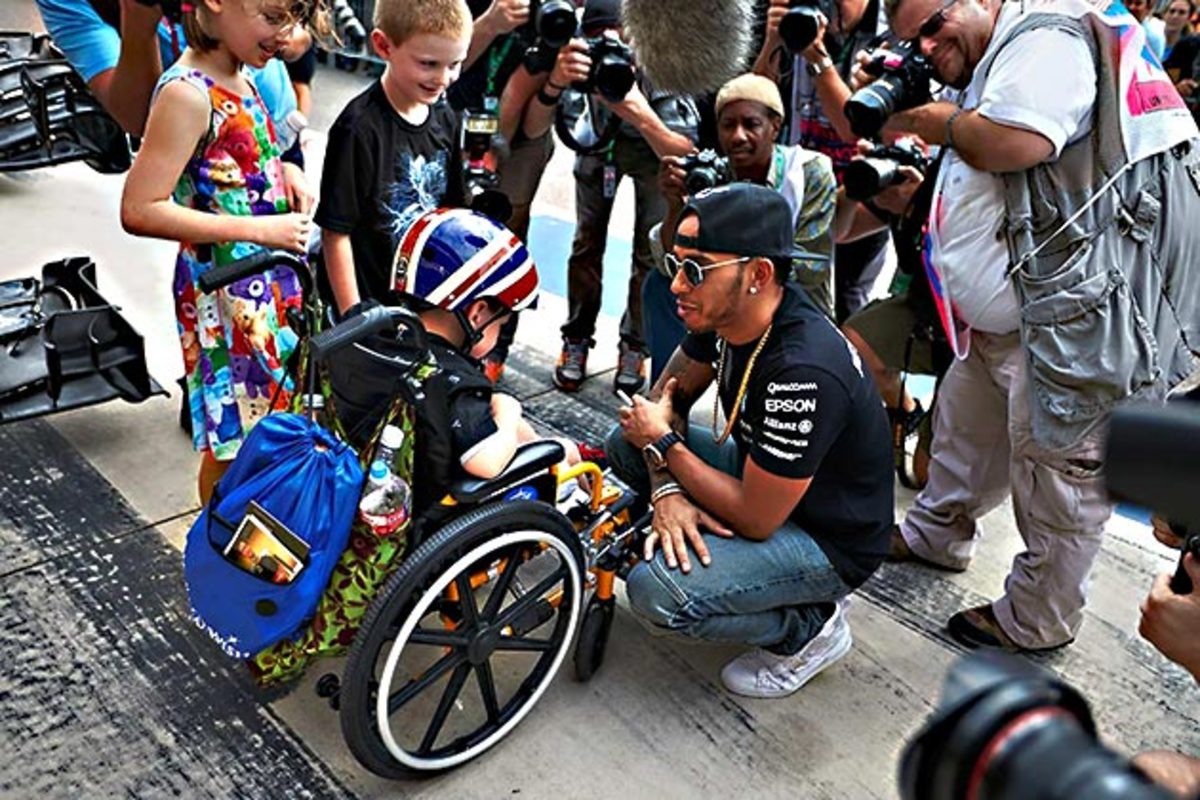
All that said: Hamilton does not suffer his critics much. As far as he’s concerned, “they hate us cuz they ain’t us” and “I honestly don’t give a care, a damn, what people think. Because I arrive [at the track], and I kill it. So I’ve got that.” His is a swag with a clear antecedent—Muhammad Ali. Hamilton’s diverse appeal is evident in the multi-hued, cross-generational throngs that gravitate to him at every F1 stop.
One of those faces in the crowd was a cherub-faced 12-year-old named Nicholas—who, through his dad’s tenuous connections, secured a VIP pass from Mercedes. When Hamilton saw Nicholas, who suffers from muscular dystrophy, in the hospitality tent, the racer doted on him like he was his own brother—also named Nicholas, and a cerebral palsy sufferer.
Ethan, the young actor from the go-karting excursion, was another of those faces in the crowd. He was the boy leading the impromptu game of 20 questions before the race, the only one in the cast to bring his own prop—a BMX helmet. You should’ve seen the glow on Ethan’s face after he finally worked up the courage to ask Hamilton to sign it. There was no faking that.
Kwame Lillard was yet another face. He was the brother from the press conference who threw out the “urban black America” question. He was asking it for Joseph Love, a photographer and massive gearhead who happens to be black. So obsessed is Love with F1, carting his four kids around the world as he follows it, that he drove from Nashville to Austin with Lillard just to see Hamilton up close.
In the trunk of his Ford Flex, Love carried stacks of paintings he had done up of Hamilton in his livery. Though Love would fail in his plans to get his works displayed locally during the race weekend, he was able to get close enough to his muse to pass him a business card.
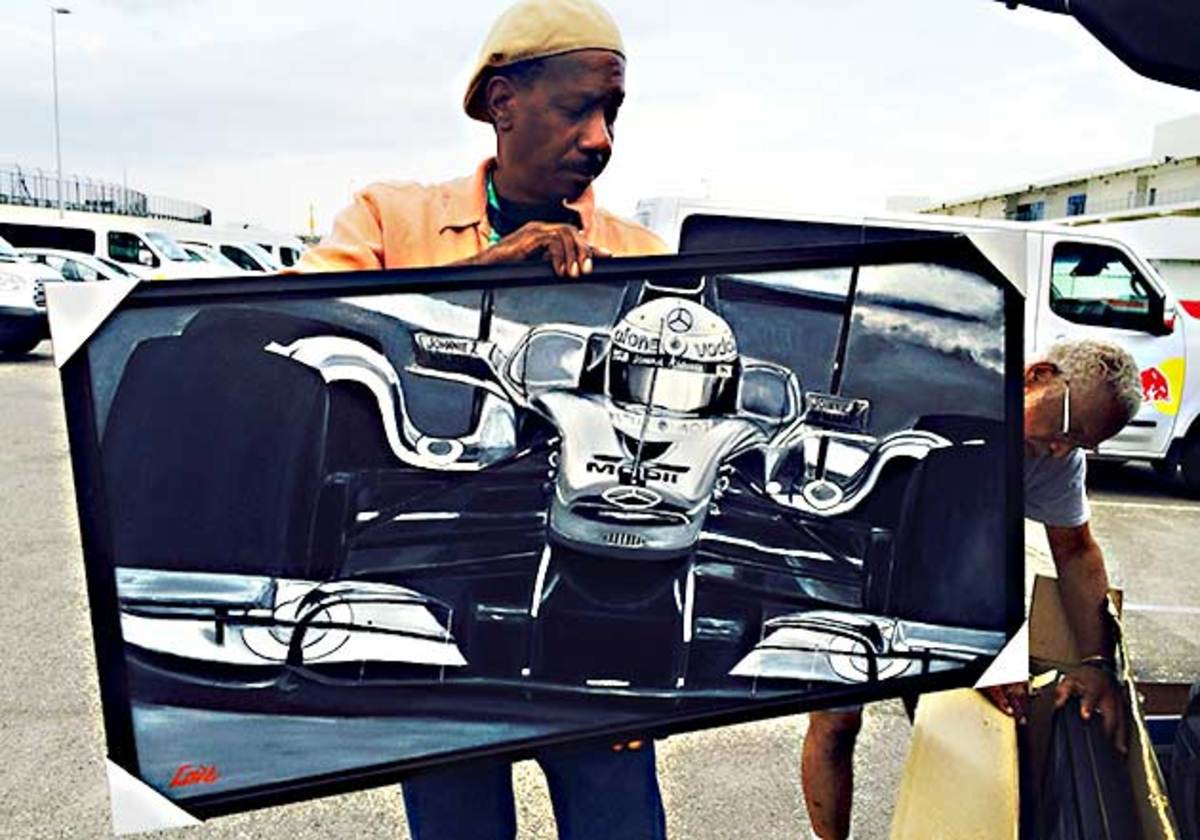
Even Trevor Noah, the host of The Daily Show, had to come down to Austin to watch Hamilton do his thing. Formula 1 is a massively popular sport in Noah’s native South Africa, where he grew up under apartheid. That someone like Hamilton could climb to the very top of it is mind-blowing. “It’s amazing for somebody like me to see somebody like Lewis, as you say, on the top of the podium in a world where you never saw pictures of yourself, ever, growing up,” Noah says. “Everybody sees a piece of themselves in Lewis, and that’s a fantastic place to be in.”
Hamilton is convinced he wouldn’t have such a profound effect on so many people if he weren’t biracial. “I always say that I’ve got the best of both worlds because, you know, I don’t have darker skin like yourself,” he says, reaching across the table to hover a hand over my bare forearm. “I’m mixed race, so I’ve got the best of the white side from my mum, and my dad’s the same color as you. But you can’t say I’m white. Because you’re one or the other. You know what I mean?
“When people would refer to me, I’m black. But I feel that’s an advantage. When I arrive here [in America], I don’t feel different, but I know I am different. When you stand me in a crowd of 20 drivers, I stand out from them. Not only do I do that, which is a blessing of being in the sport, being different to everyone, but I do it [hits the table] better than anyone.”
While the issue of race in motor sports remains a glaringly unresolved one, Hamilton believes he’s making a difference “just inherently by me being here,” he says. “But my goal’s not just to inspire young black kids; it’s all kids—white, Asian—just to show them that it’s open to everyone. It’s not just for one race. It’s for a mixture. And it should be mixed. When I was growing up, it was like, well, you can’t be a Formula 1 driver because there’s never been a black Formula 1 driver. Well, it doesn’t mean there can’t be.”
Fairy tale
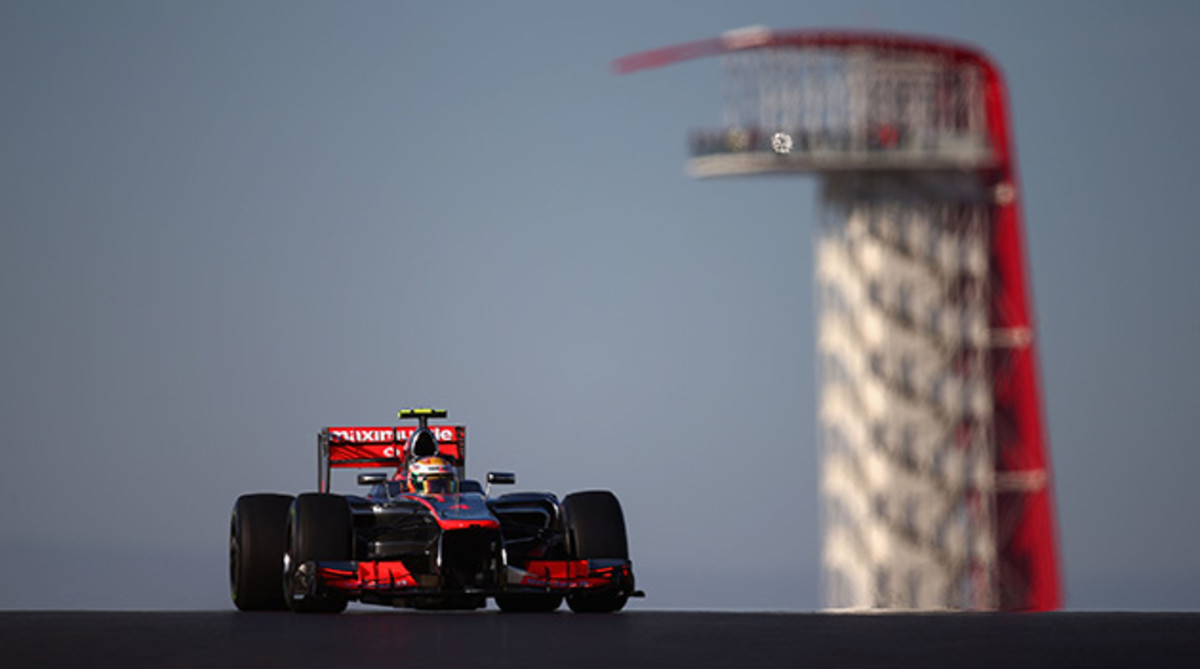
Hamilton’s home world is a place called Stevenage, a town of about 86,000 that sits about 30 miles north of central London. Anglophile TV nerds will know it as the setting of Saxondale, an off-beat comedy that starred Steve Coogan as an exterminator who torments the local townsfolk with old war stories from his heydays as a rock ’n’ roll roadie.
The show makes Stevenage seem like a nice enough world, a stereotype of suburban Britain. But Hamilton promises that place is nothing like the one where he was raised. He lived in a counsel estate, the American equivalent of public housing. “Opposite,” he says, “was a freakin’ drug house.” He listened to Tupac and Biggie and identified strongly with their lyrics. That STILL I RISE slogan on the back of his helmet? That’s Tupac.
Hamilton’s parents separated when he was two. He started out living with his mother, Carmen, and his half sisters Nichola and Samantha. Carmen didn’t have a car, “so we’d walk into town,” Hamilton recalls, “which would take an hour or whatever it was.” By age 6, Hamilton was old enough to ride a skateboard—and absorb an impact from a stray motorcycle. “I was scratched and bruised,” he says, “but nothing broken.”
All the while Hamilton’s father, Anthony, a Brit by way of Grenada, remained a strong presence in his life. At age 12, Hamilton went to live with his father, his stepmother, Linda, and Nicholas, his half-brother. Around the time Hamilton scored that skateboard, his old man bought him a go-kart. Together, the two would troop out to the parking lot of their local big-box home improvement store until Hamilton was old enough to race on a proper track.
That started at age eight. The trophies rushed in quickly. Two years later, while picking up some of hardware at an awards ceremony in London, Hamilton ran into a man named Ron Dennis—then the boss of one of F1’s super teams, McLaren Mercedes. With an autograph book at his side, Hamilton approached Dennis and said, “Hello Mr. Dennis. I’m Lewis Hamilton, and one day I’d like to race for your team.” Then Hamilton asked for an autograph and Dennis’s phone number. Dennis cheerily obliged and added a note—ring me “in nine years.”
Three years later, while Hamilton was doing homework, the phone rang. It was Dennis, offering to sponsor the boy’s career—all the way to the big leagues—provided he kept his grades up. By this point, the boy was hurtling toward his eighth karting crown in six years’ time and seeding a rivalry with his future Mercedes teammate Rosberg. Dennis’s call couldn’t have come soon enough for Anthony, who at one stage was holding down four jobs and refinancing his mortgage “just to keep the bloody go-kart going,” says Hamilton.
In 2001, at age 16, he graduated to racing cars and spent the next five years climbing the Formula 1 ladder; he’d go on to win three major single-seater titles—the last on the GP2 circuit in 2006, after collecting five victories in 21 starts. That was enough to earn Hamilton a seat in McLaren’s second F1 car, alongside a brash Spaniard named Fernando Alonso.
At this juncture, Alonso was F1’s alpha dog, a repeat world champion. The expectation was just that Hamilton, as the new jack, would take a subservient role; it was that he would yield to Alonso on the track, especially if the Spaniard were in position to win races. But the rookie would not be moved. In Year 1, Hamilton won four races and finished tied with Alonso for second place in the standings—a point behind the eventual champion, Ferrari’s Kimi Raikkonen. A year later Alonso left the team, and Hamilton won the championship—by one point. “A fairy-tale story” is how Hamilton would describe it at the time.
Mayweather money
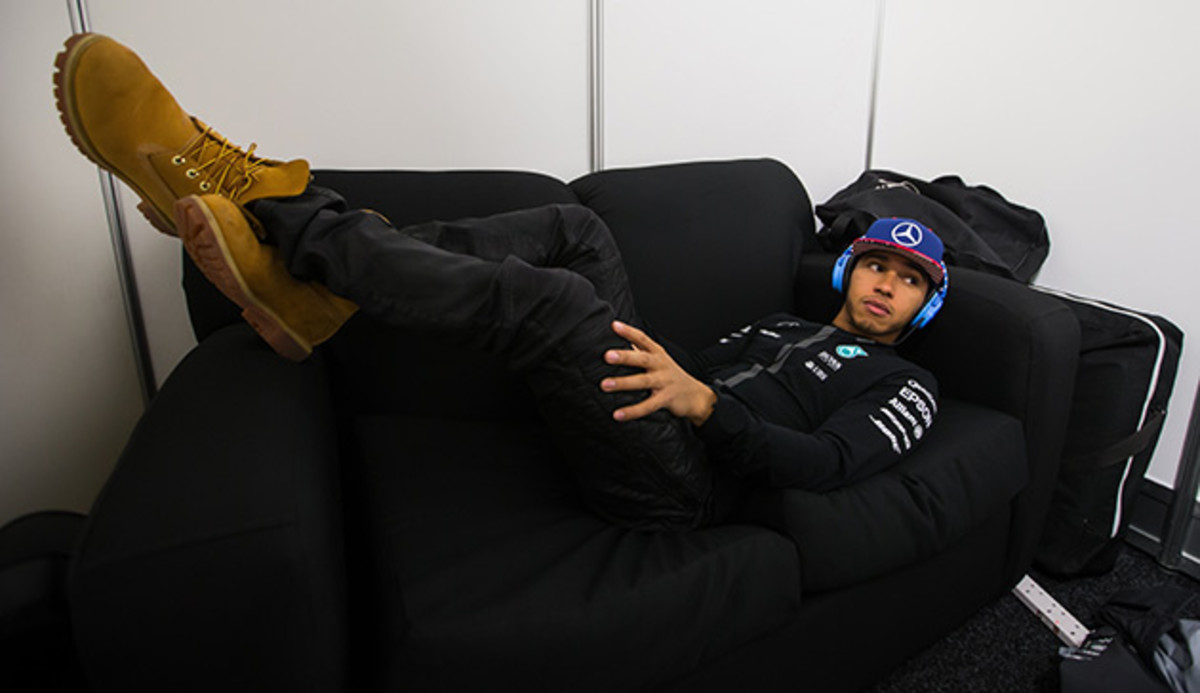
Hamilton’s happily ever didn’t last long. The next three years were a struggle. His urgency to win admittedly tapered as his celebrity increased, and McLaren’s technical program stalled. By 2012, Hamilton looked, for all the world, like a one-off champion and a reckless driver. (Three of the seven DNFs he posted that year were the result of crashes.) Hamilton was also soon to be a free agent. After a 24th-place finish in Singapore, he found himself cornered by Niki Lauda, the three-time F1 champion of Rush fame.
Lauda had recently joined forces with Mercedes, which had recently broken from McLaren to revive its F1 program. The “Silver Arrows” have a long, storied history in Formula 1—one piloted by legends of the sport like Britain’s Sterling Moss and Argentina’s Juan Manuel Fangio, a five-time champion. (“Fangio’s amazing,” Hamilton gushes.) But after a Mercedes racer veered off course at the 1955 24 Hours of LeMans, the car maker mothballed its F1 program until the mid-90s, returning as an engine supplier. In 2010, the company struck out again as a “factory team.”
Lauda wanted Hamilton to join up. Hamilton’s response: Why would I move? McLaren could bounce back from a slump. But Mercedes? They couldn’t even speed up The Mighty Schumi, who came back to F1 after three-year retirement to legitimize Mercedes’s efforts and came away winless.
Lauda cut to the chase. “I said to him if you’re going to be world champion with Mercedes—for your image, for your reputation—it’s different than if you’re world champion for McLaren,” he says. “Ferrari or Mercedes is a unique possibility. That convinced him in the end to sign a contract with us.” That deal, for three years, was reportedly worth nearly $100 million. Chump change for Merc, considering Hamilton delivered a title two years after signing. So they gave him another $155 million last May. That’s damn near Mayweather money. To justify it, Hamilton would have to bring home title No. 3, and soon.
Three the hard way
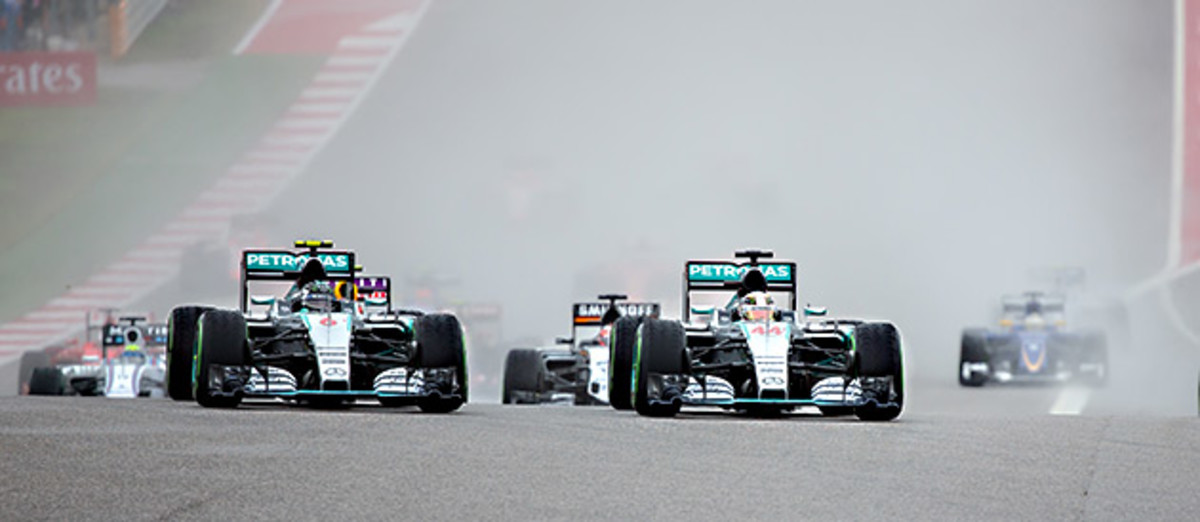
Four days of steady rain threatened to wash Hamilton off course. It nearly turned the Circuit of the Americas into 3.4-mile, 20-turn, white-water rafting course. The rains disrupted Friday’s practice sessions, pushed Saturday’s qualifying into Sunday morning, and then scrubbed it altogether barely halfway through. Nonetheless, Hamilton found his way to the second spot on the grid, right along side his best frenemy, Rosberg.
The race began just as the rain tailed off. The two Merc drivers surged up a long straightaway, nose-to-nose, giant plumes of mist spraying from their back tires. But then just as they reached a left-hand hairpin at the crest of the hill, Hamilton, on the inside line, nudged Rosberg out of the lead and down into fourth place.
With every lap, the course gets drier and Hamilton’s car, on wet tires, can’t keep up the pace. On the 15th go-round, Hamilton is overtaken by Riccardo, the Australian Red Bull driver. Three laps later, after getting passed again—by Rosberg—Hamilton ducks into the pits. Timing is everything. The constructors, no matter how many cars they field, only get one pit box to service them all. Right of way is generally assigned by running order.
By holding off Rosberg for just long enough, Hamilton gets first crack at a set of slick tires just as everyone on pit road is radioing into their drivers to switch up. Rosberg doesn’t get a chance until lap 20. But two laps later, he takes the lead. By lap 25, he’s stretched his advantage to nine seconds while Hamilton, running third and climbing despite still struggling for traction, gives chase.
On lap 38, Hamilton catches a major break just as he takes over second place, in the form of something called “a virtual safety car”—or F1’s version of the remote power switch he was hit with at the go kart track earlier. Though this helps close up the gaps in the field, Rosberg is able to pit just before he has to “follow” the virtual safety car. Meanwhile, Hamilton is caught out and has to stay out to give himself a winning chance. Rosberg’s stop lasts just three seconds, quick enough for him to rejoin the pack in third.
When the race resumes at speed, Hamilton opens a five-second gap. To hold off a surging Rosberg the rest of the way, Hamilton’s team radios in to ask if he can double that on the next go-round. “I couldn’t,” Hamilton says later. “I just didn’t have the grip on the life of the tires.” But then, another break: Kvyatt, the Russian Red Bull driver, wipes out, bringing out the safety car (the real one, this time) and giving Hamilton a window to pit on lap 44.
Now it’s Rosberg in the lead again, but on older rubber, and Hamilton merges back in second. On lap 47, the race goes green. Two laps later, Rosberg is hanging on to a margin of about a little over a second when—disaster: he overruns another bend, opening a crease for Hamilton to squirt through with five laps to go. From there, Hamilton cruises to the checkered flag and his third championship.
Measure of the man
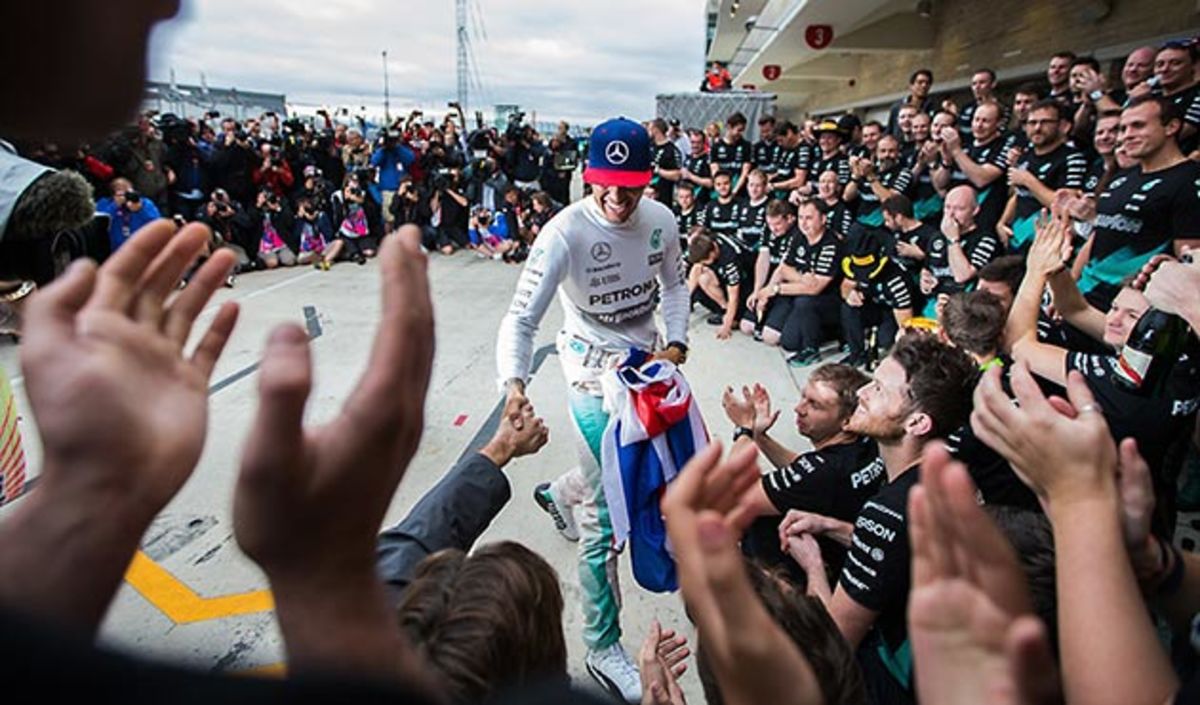
After unbuckling from his rocket and diving into the waiting arms of his Mercedes crew, Hamilton steals away to the drivers’ dressing room to prepare for the podium ceremony. He sheds his helmet, draws a series of deep breaths and kneels at the midsection of a long table at one side of the room. To his left, at the end of the table, sits his dejected teammate in a white leather chair. After a moment, Hamilton rises and examines the items on the table before him—a trio of caps for the top three finishers to wear on the riser, with their finishing positions stitched on the side. Hamilton picks up the first-place cap and tosses Rosberg the second-place lid. Rosberg wings it right back at him.
The millions all over the world who would watch this scene unfold on television, and again and again on social media, saw it for what it was: Hamilton and Rosberg’s relationship boiled down to its essence. A short time later, Elton John, who was to close the weekend with a concert, bounded onto the dais stage to twist the knife some more. “Nico!” Sir Elton began. “Congratulations! But you must be disappointed though, right..?”
Rosberg held his tongue on stage. Much later, he cried foul on Hamilton’s first-turn pass in the hairpin. Back in the hospitality suite, which was being broken down and packed up for the next week’s race in Mexico City, Hamilton defended the move thusly: “Nico had the grippier line. But I was ahead, so it was my line. We went in, and I started to turn but I just understeered into him. He was coming around and we touched. I don’t feel like I was aggressive. Of course, there’s always those kinds of comments that come up.”
Then it was on to more important questions, like whether a third title will slake his motivation (no), whether he measures himself against other great drivers (only Senna), whether he takes an extra measure of satisfaction from rallying to this victory (oh, hell yes). Through every answer, his eyes sparkle and the Cheshire grin is ever present.
It isn’t until I ask Hamilton, finally, whether he knew that the kids he’d raced go-karts with four days ago were straight from central casting that the F1 gun’s gleam dims a shade. “Really?” he says. “The kids were actors? I never knew that. Well, I feel really cheated if that’s the case." Maybe he is right to be disappointed. Epson could have netted an organic result without any choreography. (The company’s official position is that the event was not staged.) Still, the means did not in any way tarnish the ends.
The time Hamilton spent with those kids was no less authentic than the moments he shared in the Mercedes garage in the wake of his title triumph. A Union Jack draped over his shoulders, Hamilton hugged his way through a star-studded receiving line that included Noah (The Daily Show host), the Jamaican sprinter Asafa Powell, CBS This Morning anchor Gayle King and TV’s Matt LeBlanc. All the while, Hamilton's delirious Mercedes teammates hosed one another down with bottle after bottle of champagne as a swarm of photographers, Love among them, snapped away. Off to the side, Nicholas, the 12-year-old with muscular dystrophy, sat in a folding chair wearing a black Mercedes shirt and matching flat-brim cap (freshly signed by the three-time champ), doing his best to stay out of the way.
Only Hamilton can render a scene like this. Put simply: He is an unstoppable force, one with the power to make worlds collide.
GALLERY: Lewis Hamilton On and Off the Grid
Lewis Hamilton: On and Off the Grid at the U.S. Grand Prix
